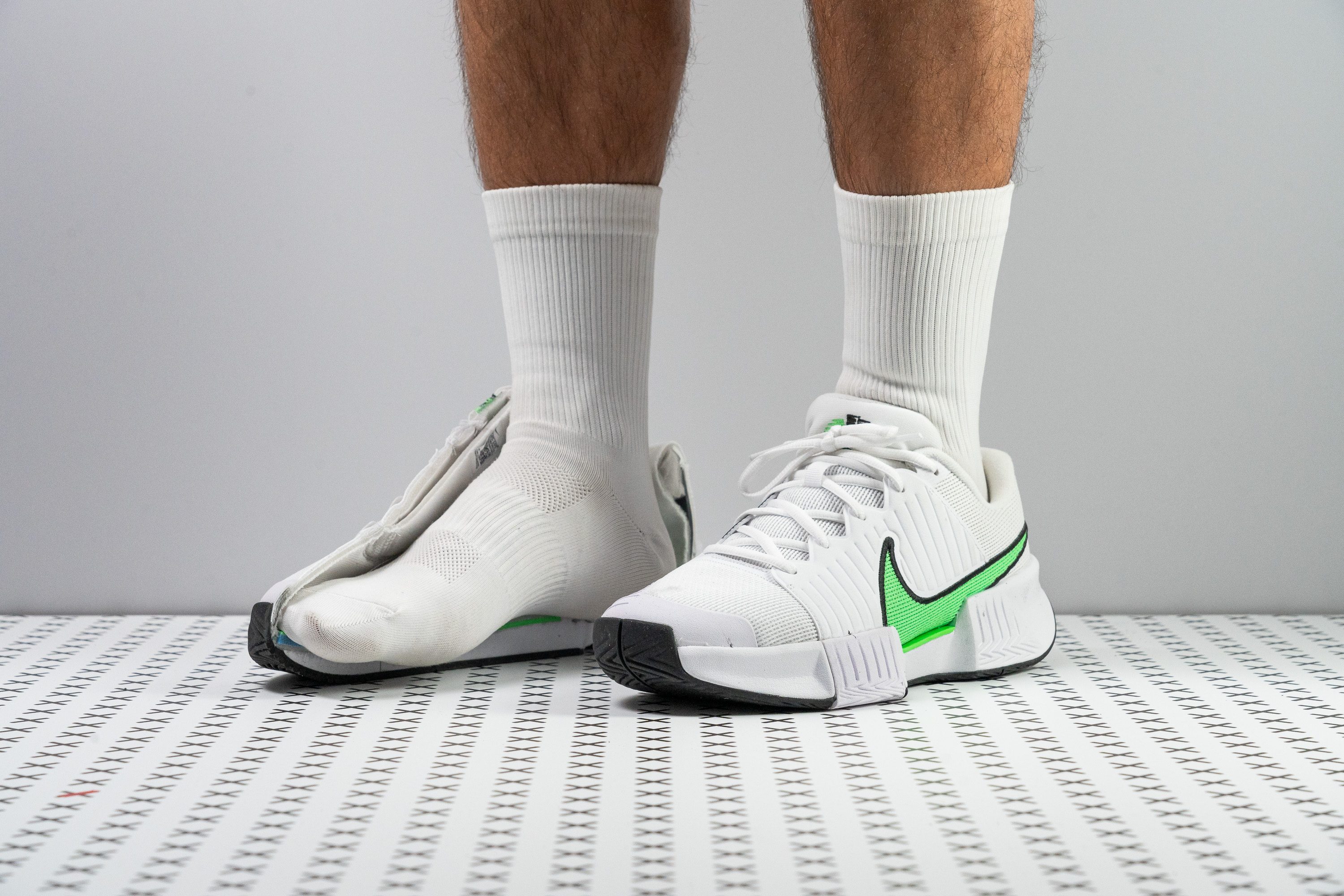Our verdict
- Top pick in best Nike tennis shoes
Pros
- Excellent stability and lateral support
- Great impact protection
- Rockered sole smoothens heel-to-toe transitions
- Stiff shank and sole add propulsion
- Sturdy rubberized drag guard
- Hard and durable rubber outsole
- Gusseted tongue enhances foothold
- Comfortable and padded in-shoe feel
- Outsole balances grip and give
Cons
- Not very breathable
- Heavier than average
- Mesh is easily damaged
Audience verdict
- Top 25% in all court tennis shoes
- Top 12% in Nike tennis shoes
- Top 29% most popular tennis shoes
Comparison
The most similar tennis shoes compared
+ + Add a shoe | |||||
|---|---|---|---|---|---|
| Audience score | 89 Great! | 90 Great! | 83 Good! | 88 Great! | |
| Price | $120 | $120 | $160 | $120 | |
| Shoe type | All CourtHard Court | All CourtHard Court | All CourtHard Court | All CourtHard Court | |
| Shock absorption | Moderate | High | Moderate | Low | |
| Energy return | Moderate | Moderate | Moderate | Moderate | |
| Traction | Moderate | Moderate | Moderate | Low | |
| Construction | Stability | Speed | Stability | Speed | |
| Breathability | Moderate | Moderate | Moderate | Breathable | |
| Weight lab | 14 oz / 397g | 12.1 oz / 343g | 14.7 oz / 417g | 12.1 oz / 343g | |
| Lightweight | ✗ | ✓ | ✗ | ✓ | |
| Drop lab | 6.3 mm | 9.4 mm | 7.5 mm | 8.8 mm | |
| Width / fit | Medium | Medium | Wide | Medium | |
| Toebox width | Narrow | Medium | Medium | Medium | |
| Size | Slightly small | Slightly small | Half size small | True to size | |
| Midsole softness | Firm | Balanced | Firm | Firm | |
| Stiffness | Stiff | Flexible | Moderate | Moderate | |
| Torsional rigidity | Moderate | Stiff | Stiff | Flexible | |
| Heel counter stiffness | Moderate | Moderate | Moderate | Moderate | |
| Midsole width - forefoot | Wide | Very wide | Average | Average | |
| Midsole width - heel | Wide | Average | Average | Narrow | |
| Outsole durability | Good | Good | Good | - | |
| Heel padding durability | Decent | Bad | Decent | - | |
| Heel stack lab | 29.7 mm | 26.7 mm | 30.0 mm | 26.4 mm | |
| Forefoot | 23.4 mm | 17.3 mm | 22.5 mm | 17.6 mm | |
| Insole thickness | Average | Average | Average | Average | |
| Removable insole | ✓ | ✓ | ✓ | ✓ | |
| Heel tab | None | None | None | None | |
| Toebox durability | Decent | Good | Decent | - | |
| Outsole hardness | Average | Average | Average | Average | |
| Outsole thickness | Thin | Thin | Average | Average | |
| Ranking | #7 Top 18% | #5 Top 13% | #26 Bottom 33% | #10 Top 26% | |
| Popularity | #11 Top 29% | #31 Bottom 20% | #15 Top 39% | #24 Bottom 38% |
Who should buy
We believe that the Nike GP Challenge Pro is a solid option to consider if:
- you are a beginner player looking for an affordable shoe
- you want a middle-ground shoe between a cheap trainer and a more professional option
- you need a good amount of lateral support and stability in your tennis footwear
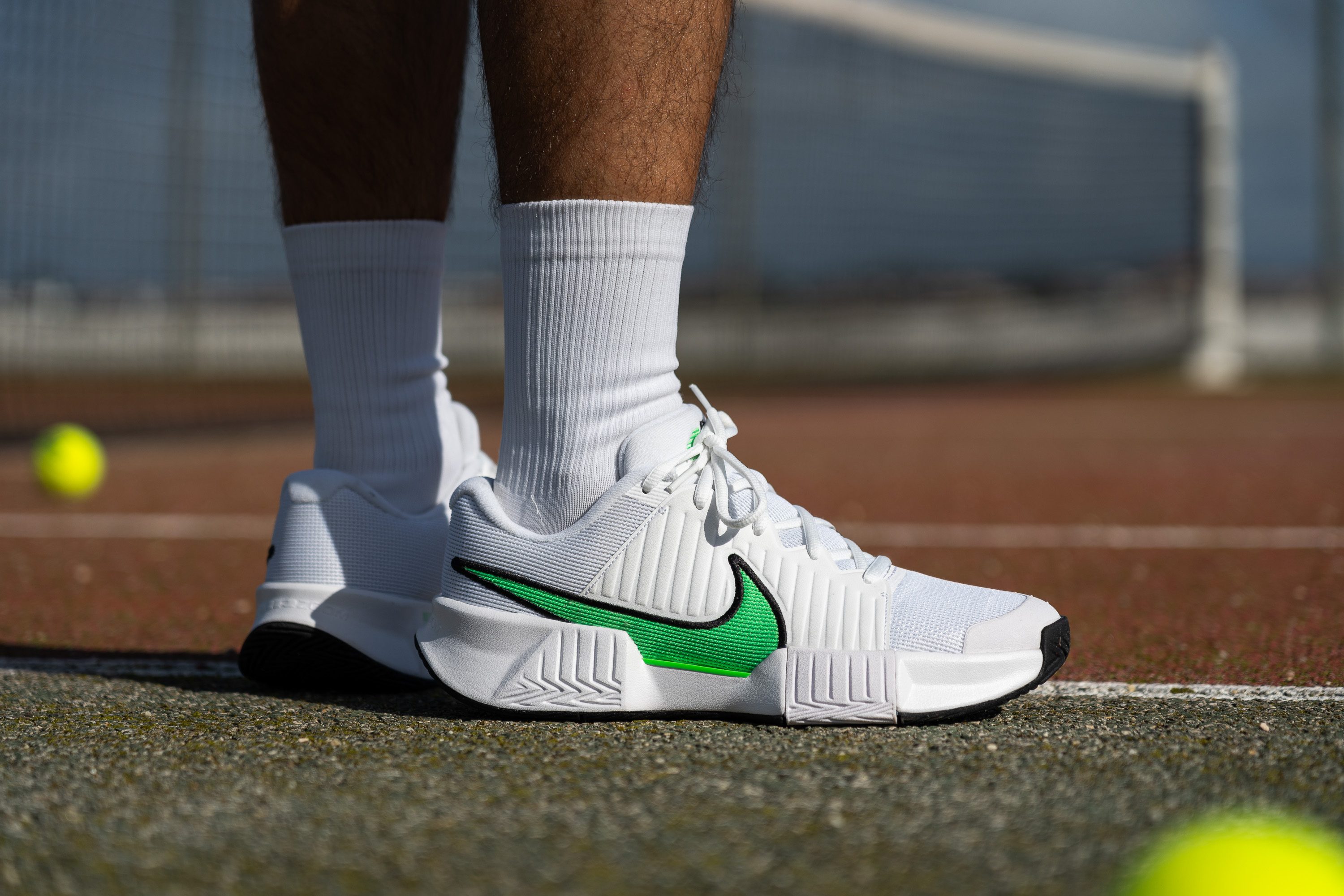
Who should NOT buy
The GP Challenge Pro will not make the best option for players with wide feet. We recommend that these folks check out the K-Swiss Hypercourt Express 2 or the Adidas Solematch Control.
If you are willing to explore a more enhanced version of this Nike shoe, check out the Nike Zoom Challenge 1.
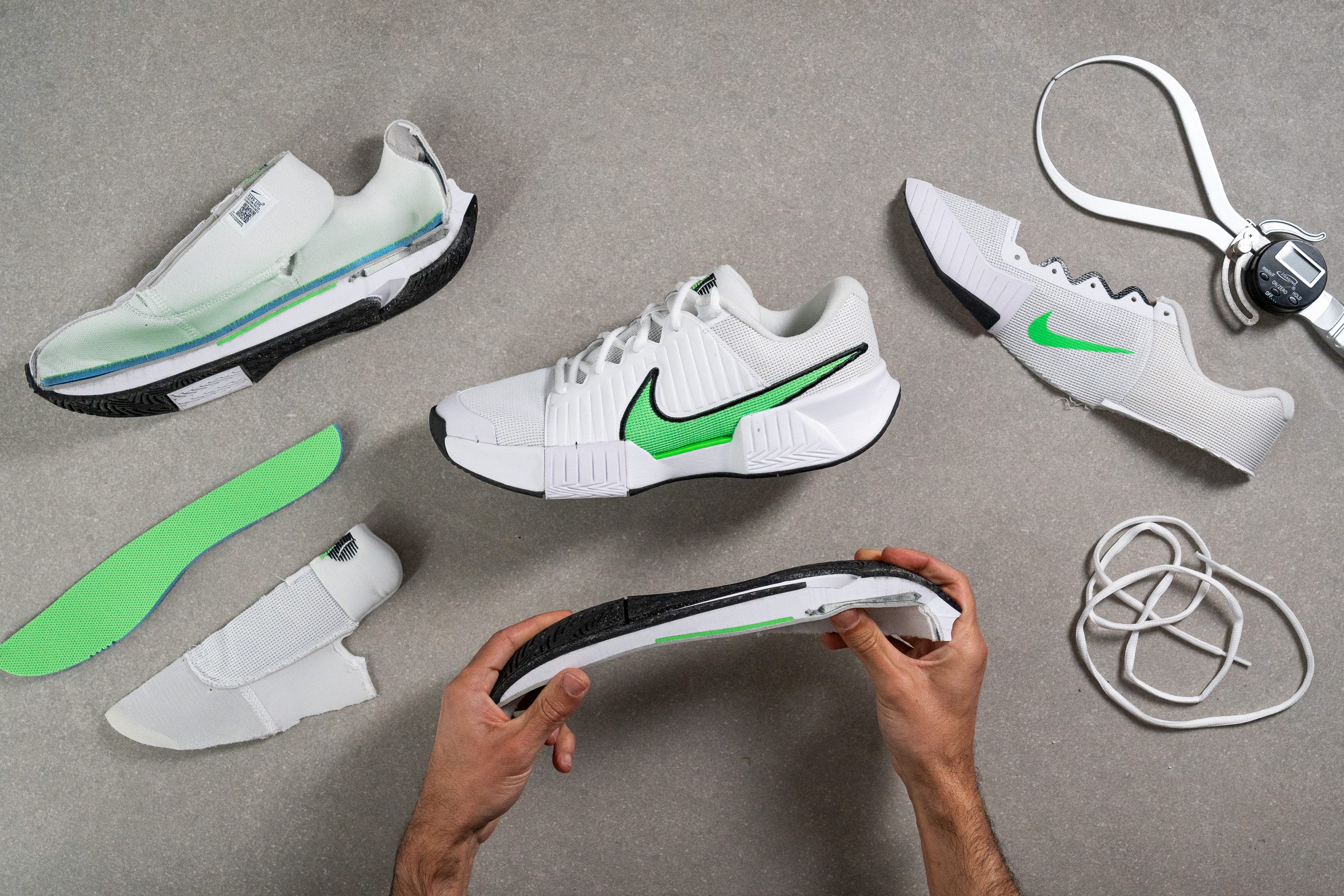
Cushioning
Shock absorption
Playtesting the GP Challenge Pro, we found it to be rather well-cushioned and protective on hard landings. Our observations were backed up by the lab test results which showed above-average shock absorption in both the heel (101 SA) and the forefoot (80 SA).
A large Zoom Air unit in the heel is part of the shoe's cushioning equation. It squishes and bounces back to make sure you land safely on your heels, but doesn't compromise the overall stability of the shoe.

| GP Challenge Pro | 101 SA |
| Average | 99 SA |
Energy return
However, this Air unit didn't elevate the shoe's energy return much higher than the average, showing a moderate reading of 51.3% in both the heel and the forefoot.
That gives the GP Challenge Pro a moderately dynamic yet balanced and sufficiently stable ride.
| GP Challenge Pro | 51.3% |
| Average | 48.8% |
Heel stack
Based on our caliper measurements, its heel stack height comes in at 29.7 mm which is an average reading across tennis shoes.

Oh, and we can't help but point out the odd rockered shape of this Nike tennis shoe!
This is a new twist that some brands have been putting on their tennis footwear, which is inspired by the running shoe design.
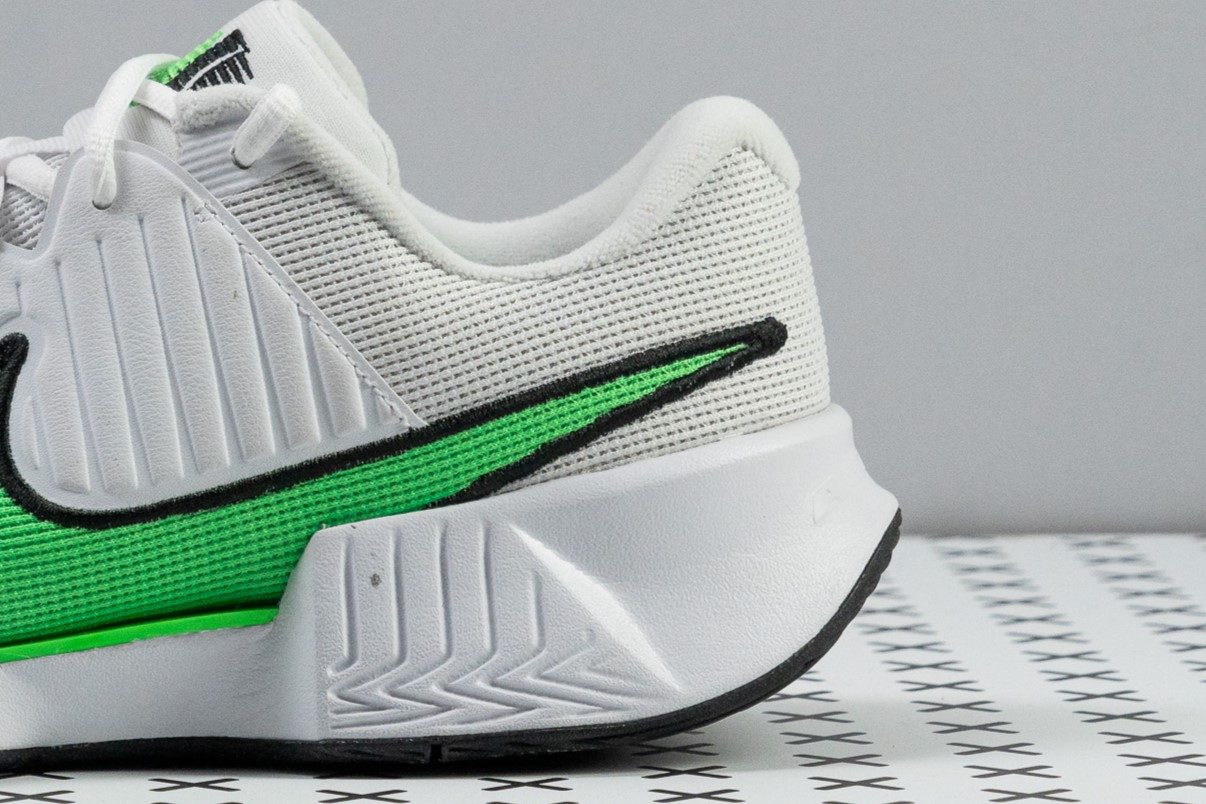
The curved shape works similarly to a rocking chair, helping the foot roll from the heel to the toes much faster and smoother. Even though it felt weird on foot at first, we quickly reaped the benefits of it when dashing forward towards the net.
It also came in very handy when we leaned back for a serve.
| GP Challenge Pro | 29.7 mm |
| Average | 29.2 mm |
Forefoot stack
We also felt that the balls of our feet sat higher off the ground in the GP Challenge Pro.
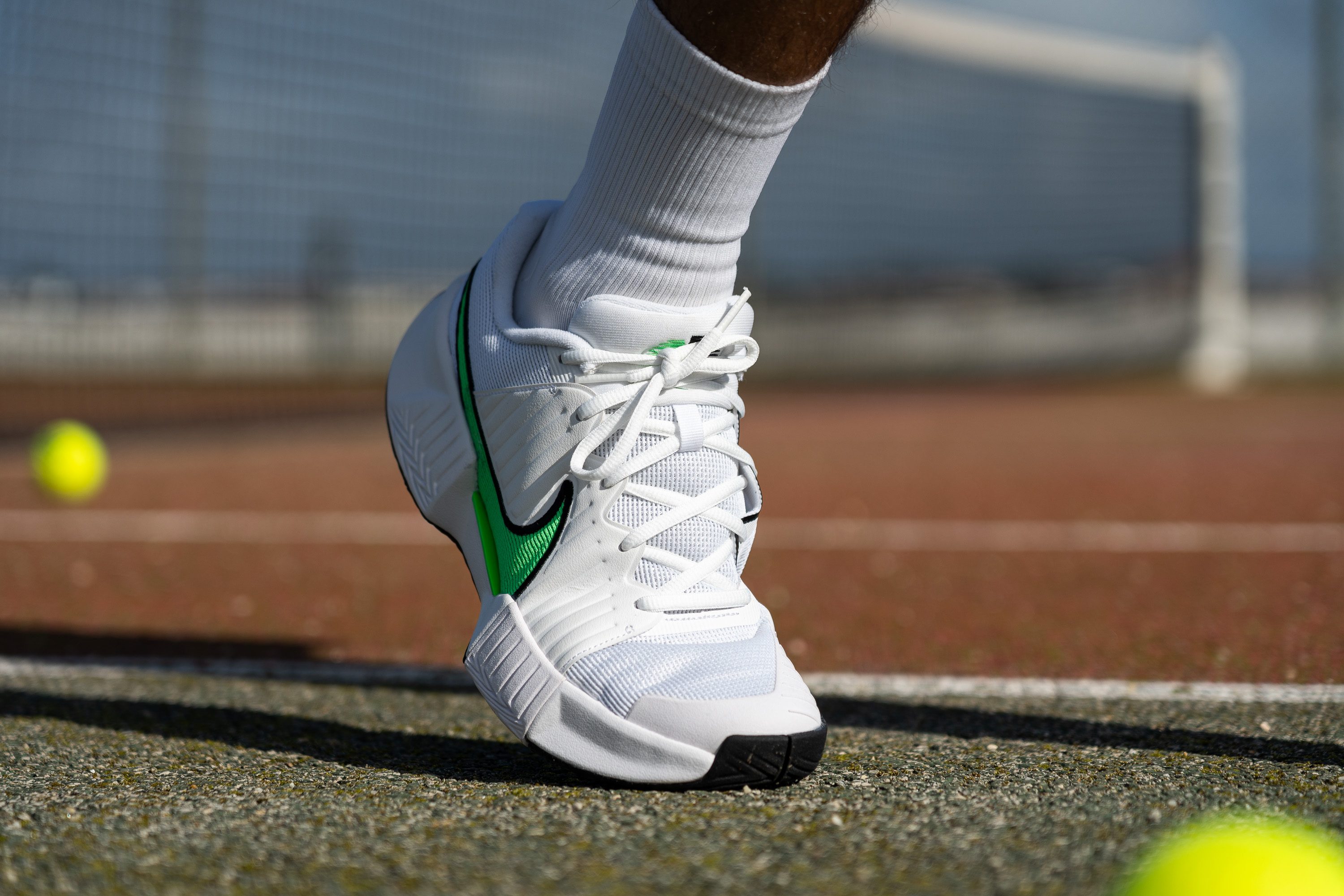
The shoe's forefoot stack height comes in at 23.4 mm which is a few millimeters than the average. This explains why the court feel isn't as pronounced in this Nike shoe.
If you enjoy a more sensitive connection to the court and better ground feedback, you will appreciate the Nike Vapor Pro much more.
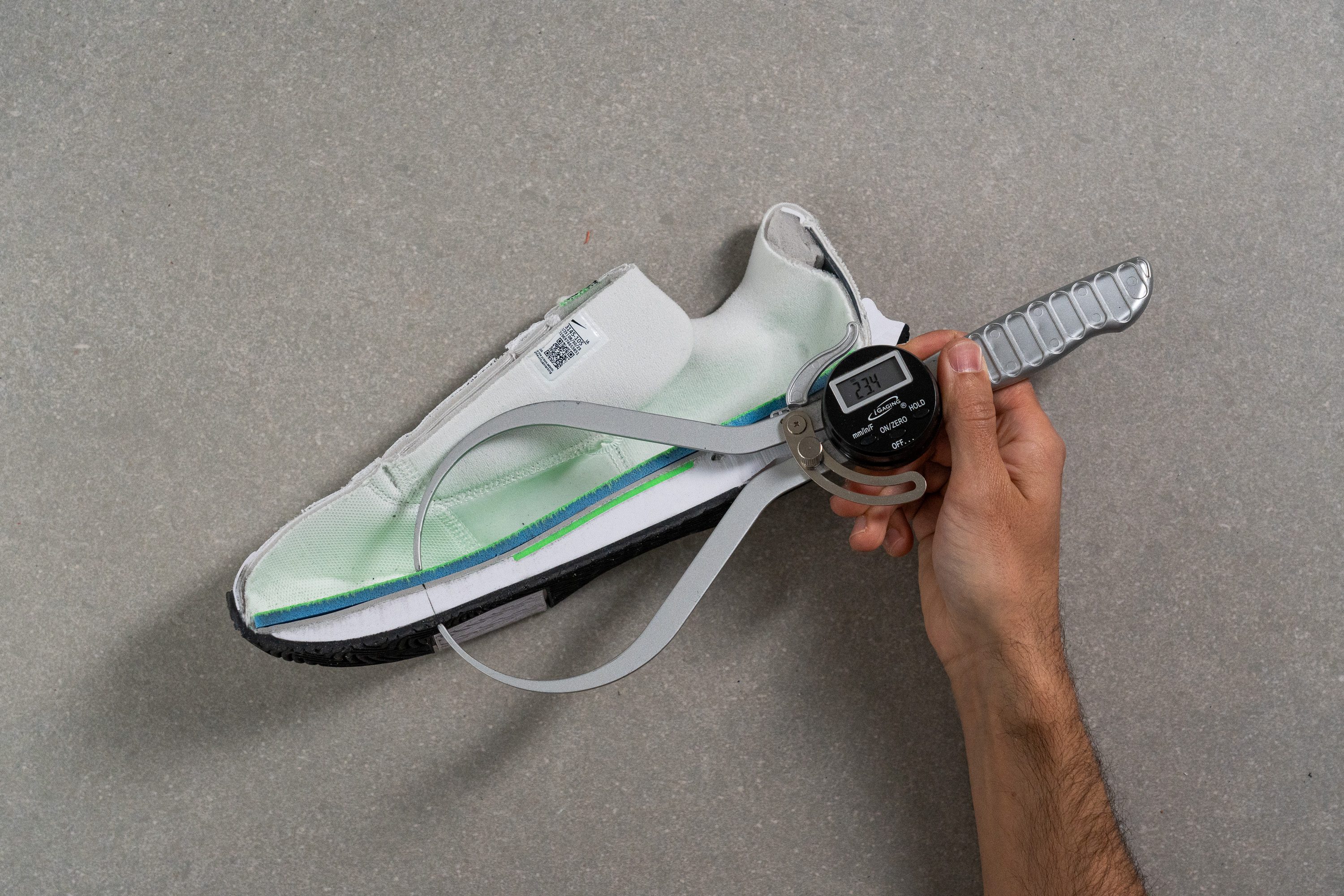
| GP Challenge Pro | 23.4 mm |
| Average | 19.5 mm |
Drop
The heel-to-toe difference in the Nike GP Challenge Pro turns out to be lower than average at 6.3 mm.
We believe that many players won't even notice the difference but seasoned athletes may feel as though their feet sit a bit flatter and more parallel to the ground in the GP Challenge Pro.
When their heels are not elevated as high, players get a higher sense of control and stability inside the shoe.
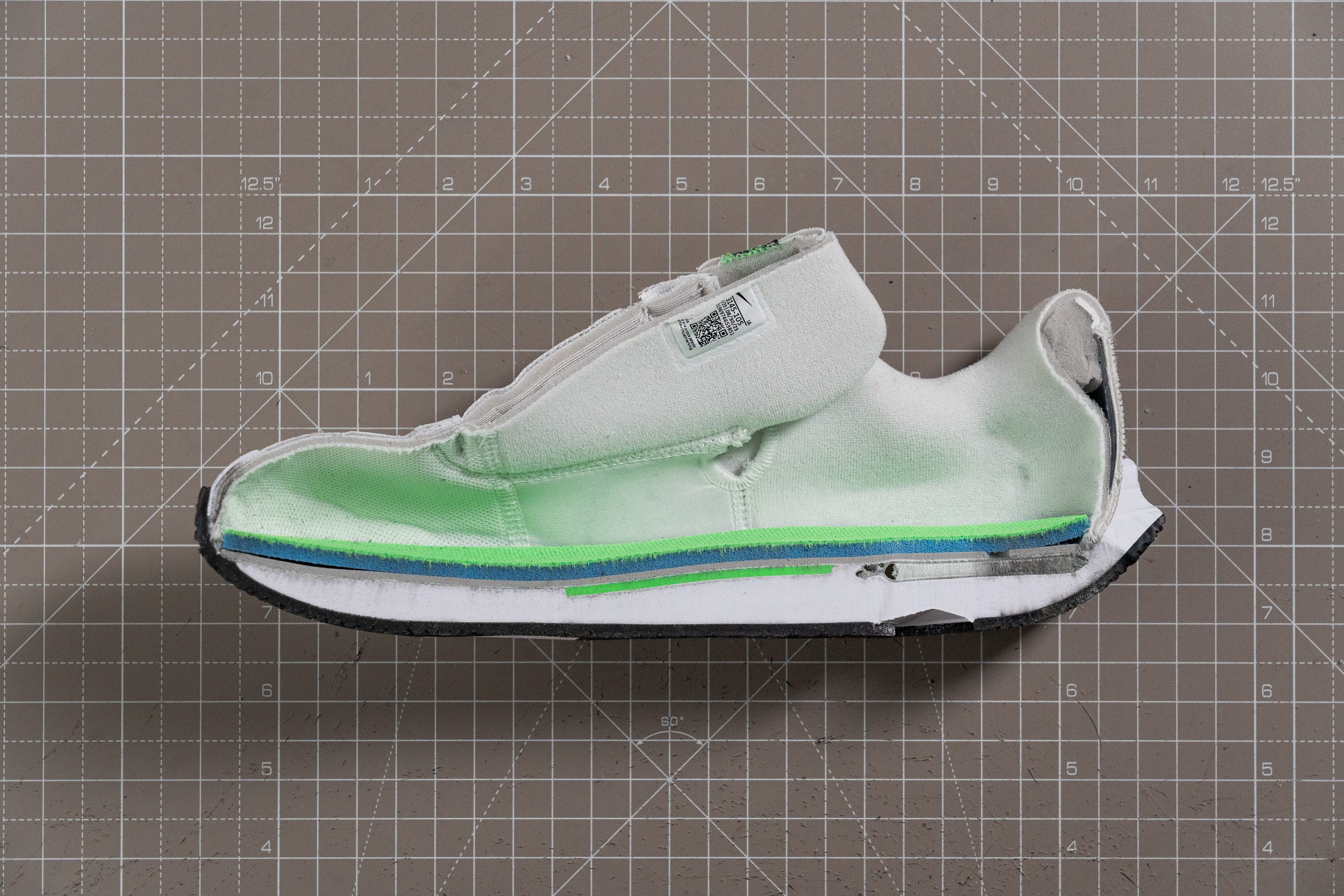
| GP Challenge Pro | 6.3 mm |
| Average | 9.7 mm |
Midsole softness
The GP Challenge Pro uses Nike's basic Phylon foam for its primary cushioning. It is a rather standard EVA foam which is common for the brand's entry-level models.
It is also a firmer type of cushioning with not much energy return.
Using a durometer, we measured the softness of the shoe's Phylon foam at 30.8 HA which is only 5% firmer than average. That is because most tennis shoes have a firmer type of cushioning to keep the player stable and connected during fast multi-directional movements.

| GP Challenge Pro | 30.8 HA |
| Average | 28.1 HA |
Size and fit
Size
Nike GP Challenge Pro fits slightly small (43 votes).
Width / Fit
Like most Nike shoes, the GP Challenge Pro only comes in one standard medium width but we found that it fits similarly to most other tennis shoes in the same width.
Retrieving a gel mold of the shoe's interiors, we measured its widest part at 92.0 mm which is on par with the average width of tennis shoes we measured in a men's US size 9.
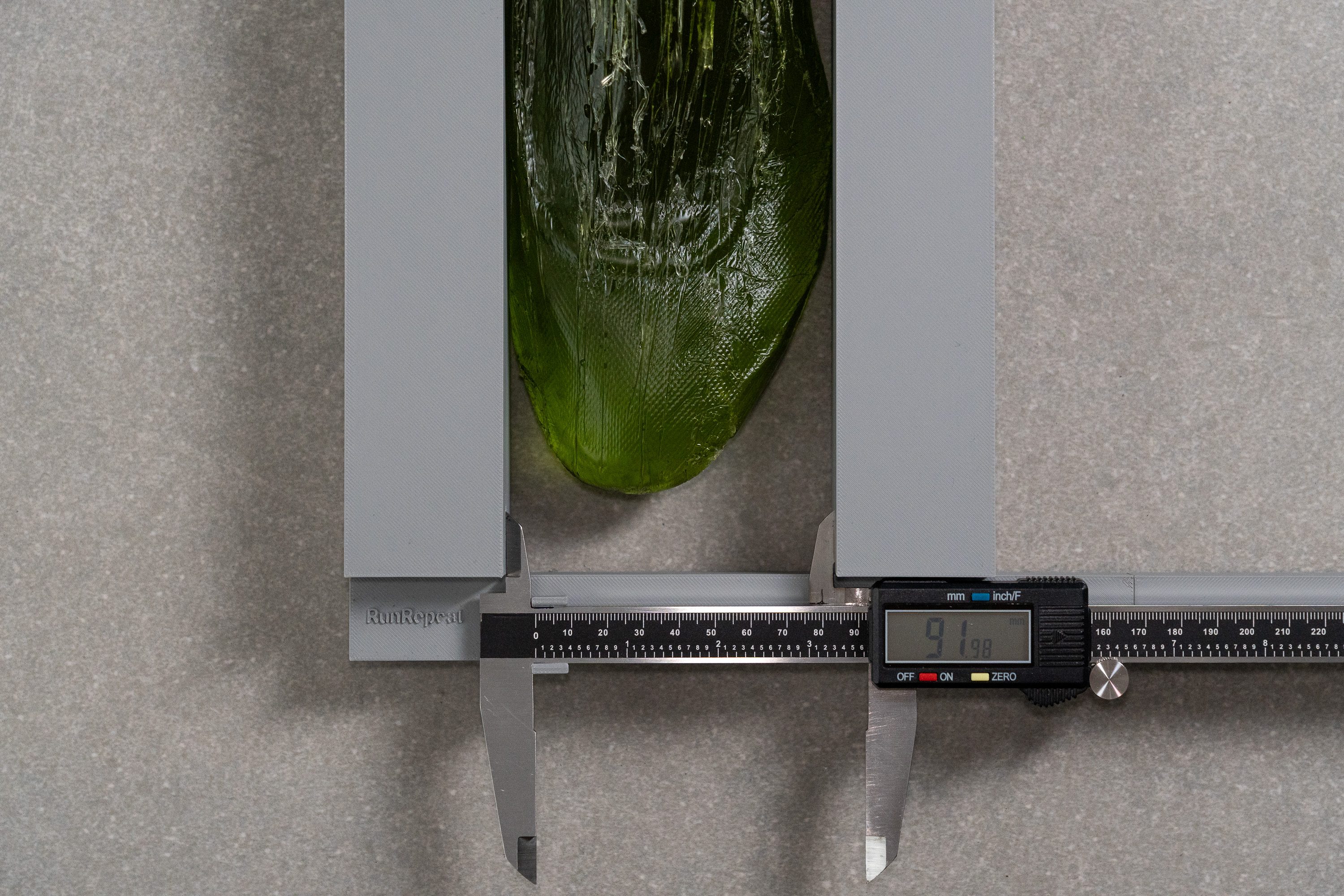
| GP Challenge Pro | 92.0 mm |
| Average | 92.9 mm |
Toebox width
However, the Challenge Pro does get pointy towards the front, narrowing down to 65.5 mm in the big toe area. That makes it accommodating only for players with narrow feet. Maybe medium as well, if such a tapered toebox matches the shape of their toes.
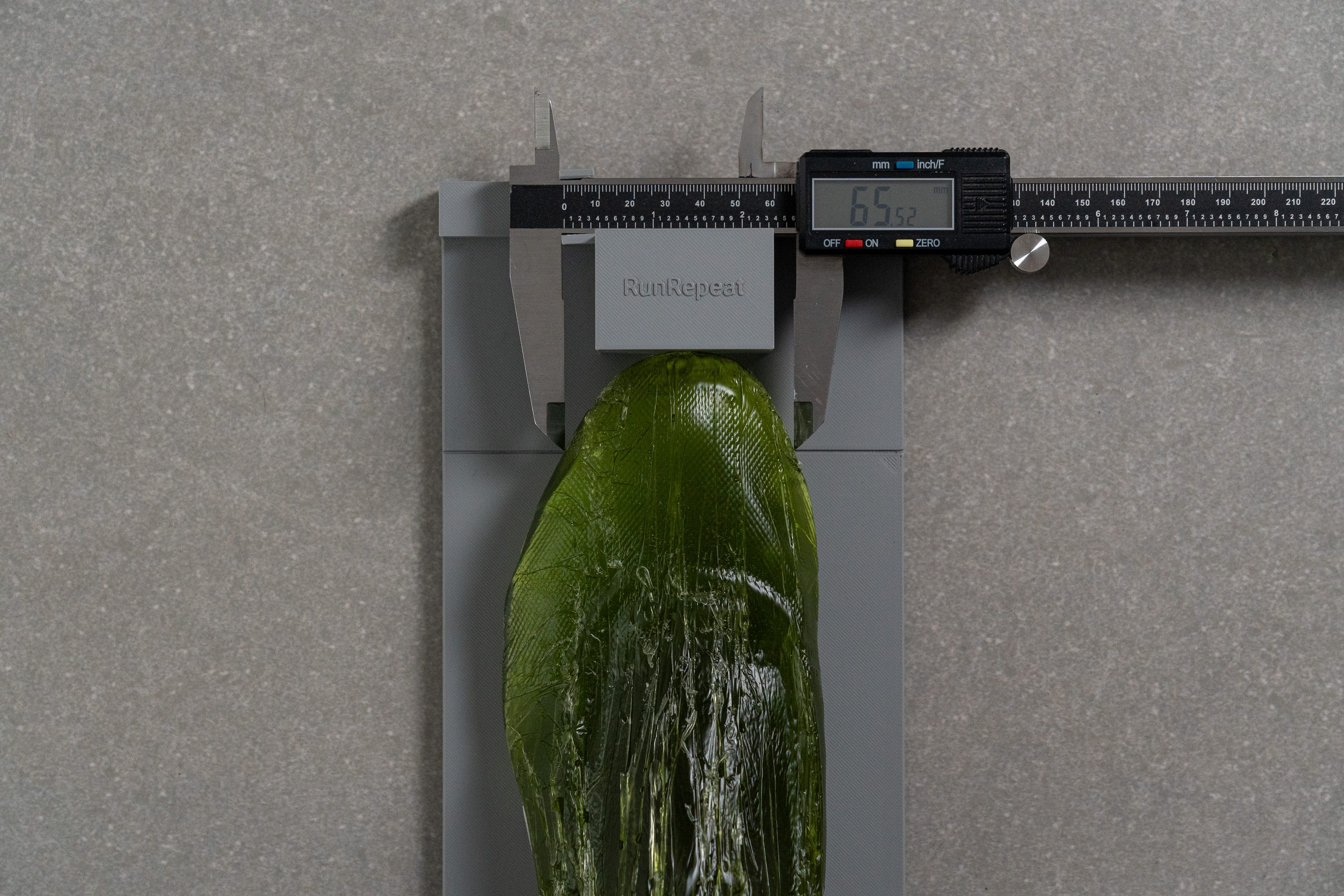
| GP Challenge Pro | 65.5 mm |
| Average | 69.2 mm |
Toebox height
The vertical space, on the other hand, is not limited in this Nike shoe clocking in at a standard 24.0 mm.
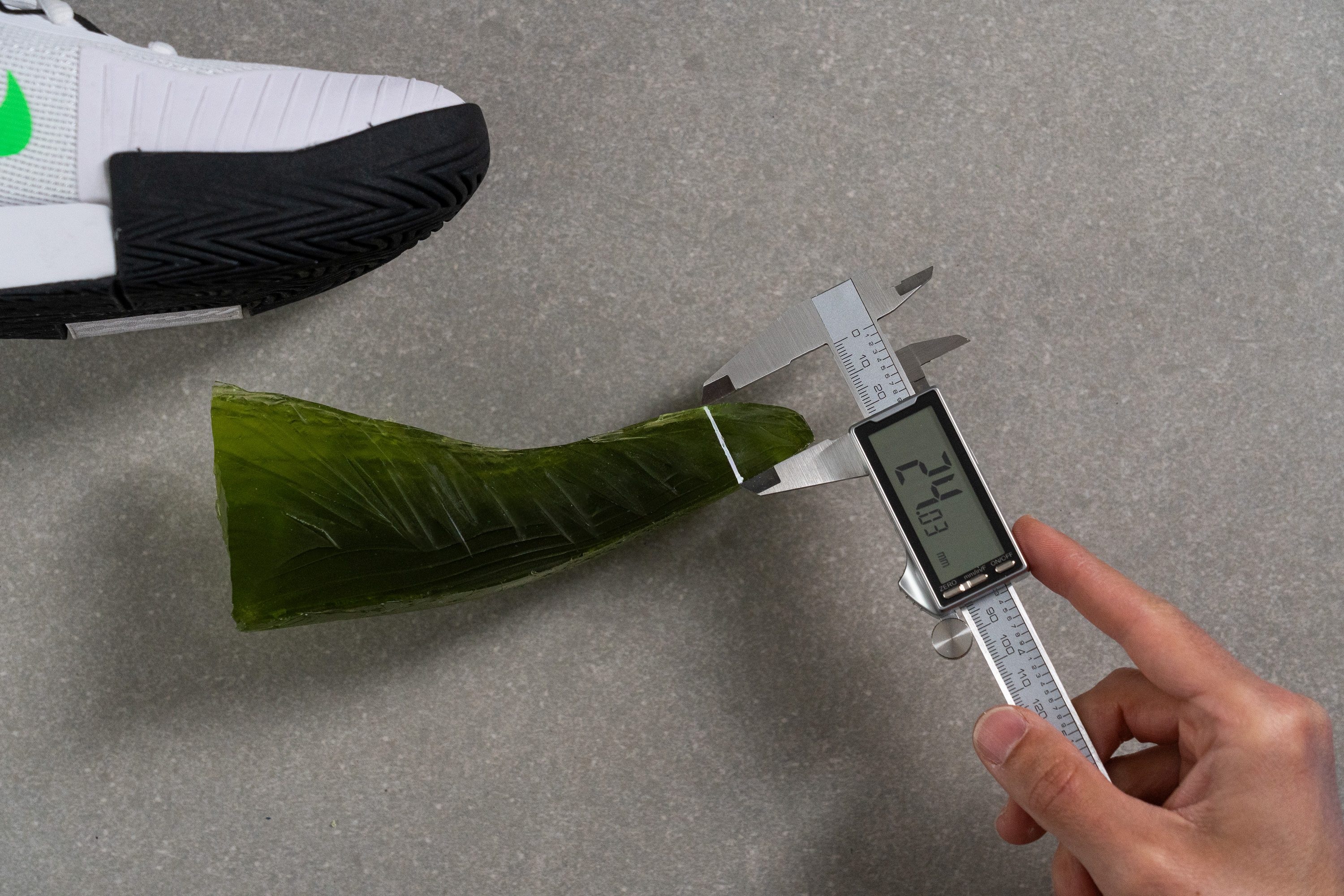
| GP Challenge Pro | 24.0 mm |
| Average | 25.1 mm |
Traction / Grip
Forefoot traction
Because the GP Challenge Pro uses hard rubber for its outsole, its grip proved to be less tacky in our lab test. Sliding the shoe's forefoot against concrete, we recorded a slightly below-average friction coefficient of 0.72.
This still means a great bite on hard court, but you will also notice a good amount of give. It took us little effort to pivot and slide out of shots in this Nike shoe.
| GP Challenge Pro | 0.72 |
| Average | 0.76 |
Outsole design
The Nike GP Challenge Pro features a full-length herringbone tread pattern which is twisted in the forefoot and heel areas to accommodate foot rotations.

Flexibility / Stiffness
With its burly midsole, high stack, and TPU shank, of course, the Nike GP Challenge Pro is far from being a fexible shoe. Even after a break-in period of several on-court hours, the shoe did not give in that much.
To measure its stiffness precisely, we bent the shoe to a 30-degree angle on a flexiblity testing machine. The latter showed that it takes as much as 21.4N of force which is significantly more than it takes an average tennis shoe.
But there are two sides to the coin: the shoe doesn't flex so easily with the foot but there is a good amount of propulsion for snappier toe-offs.
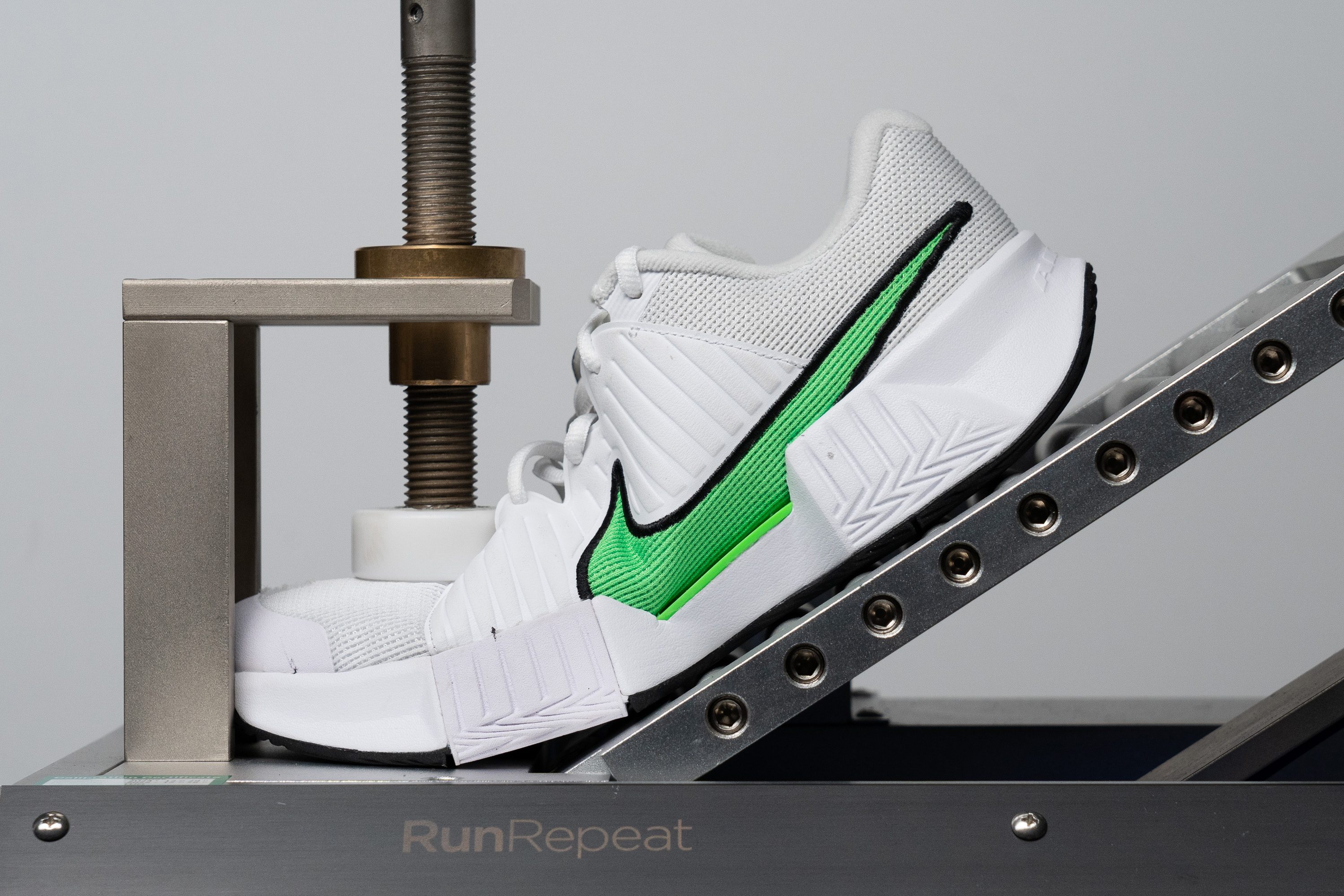
| GP Challenge Pro | 21.4N |
| Average | 16.6N |
Weight
Having a chunky sole with large outriggers and a generously padded upper, we were not surprised to find that the Nike GP Challenge Pro is a heavier shoe.

Weighing it in a men's US size 9, our scale showed 14.0 oz (397g) which is over an ounce heavier than the average tennis shoe.
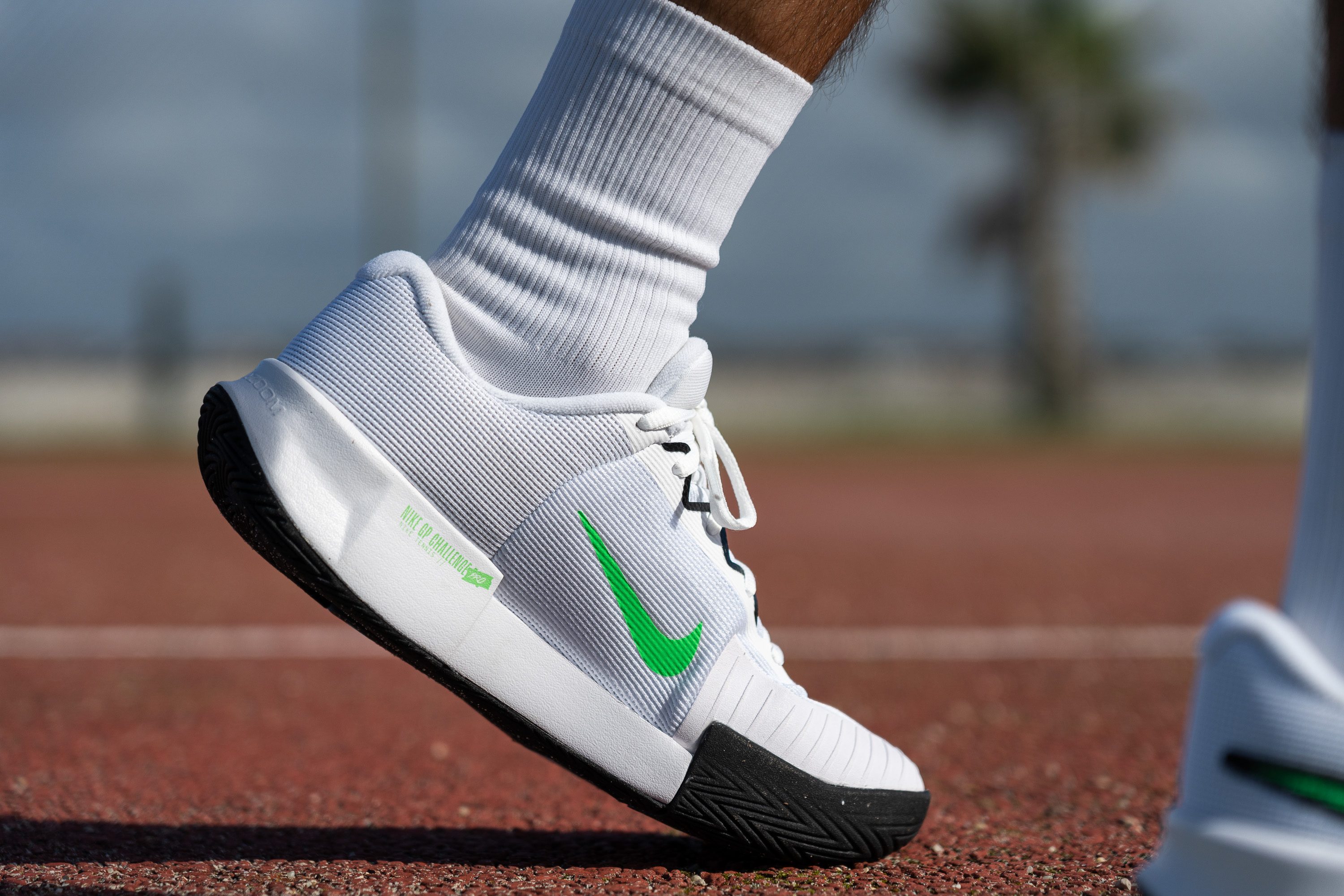
If you want a similar pack of features in a lighter setup, we recommend the ASICS Gel Challenger 14 and the K-Swiss Hypercourt Express 2.
| GP Challenge Pro | 14.0 oz (397g) |
| Average | 12.8 oz (362g) |
Breathability
It looks like Nike prioritized comfort at the cost of breathability in the GP Challenge Pro. The shoe is lined with soft and padded layers but leaves little room for ventilation.
Playtesting the shoe, we could feel that it traps heat a little more than other tennis shoes.
Even in our smoke-pumping breathability test, the smoke could only pass through the small gap between the tongue and the upper. The shoe's toebox mesh doesn't provide much airflow.
We turned to our microscope to take a closer look at the mesh.
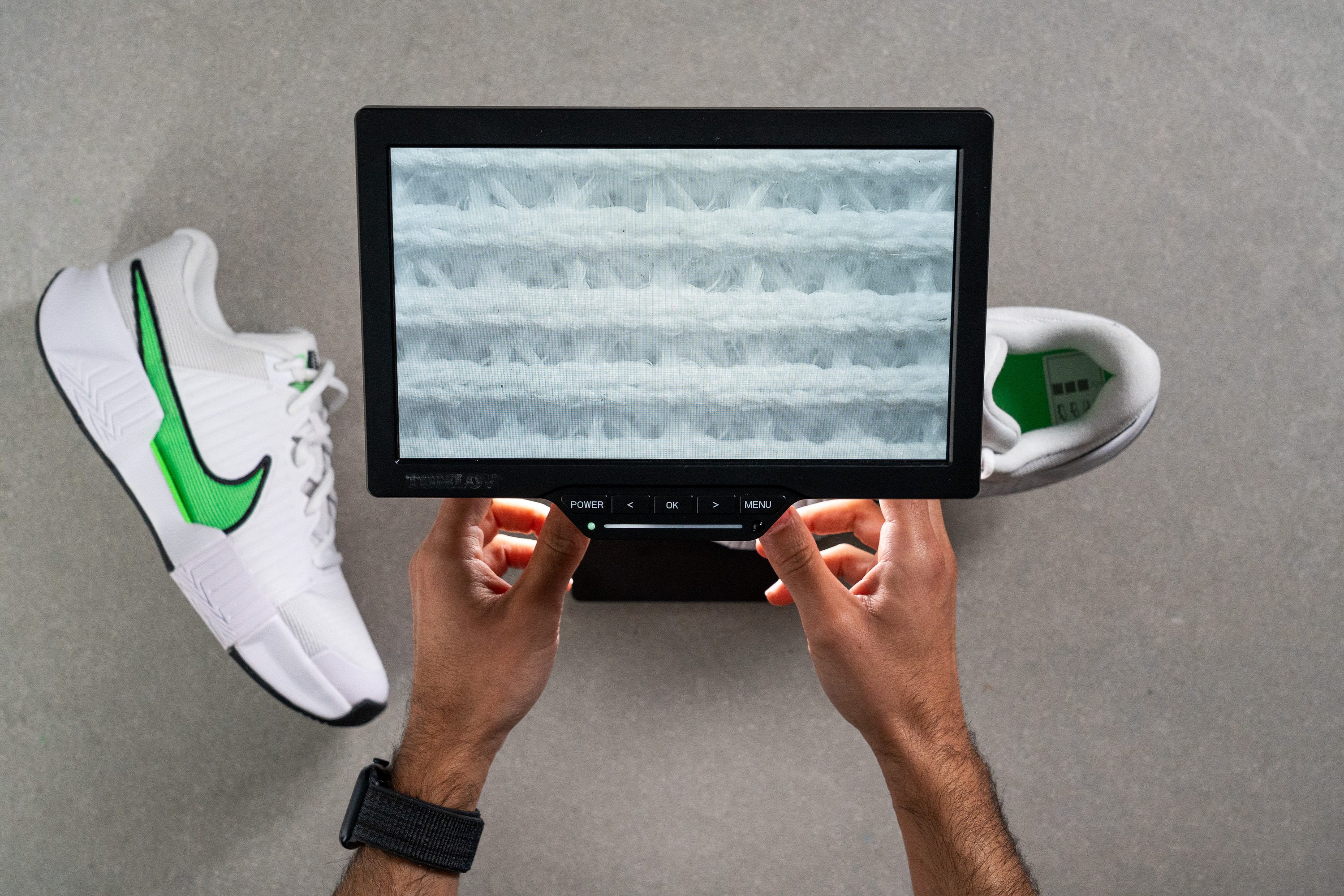
Just as we expected, the fabric comprises multiple layers of mesh stacked on top of each other. As a result, ventilation pores end up rather small with little ventilation capacity.
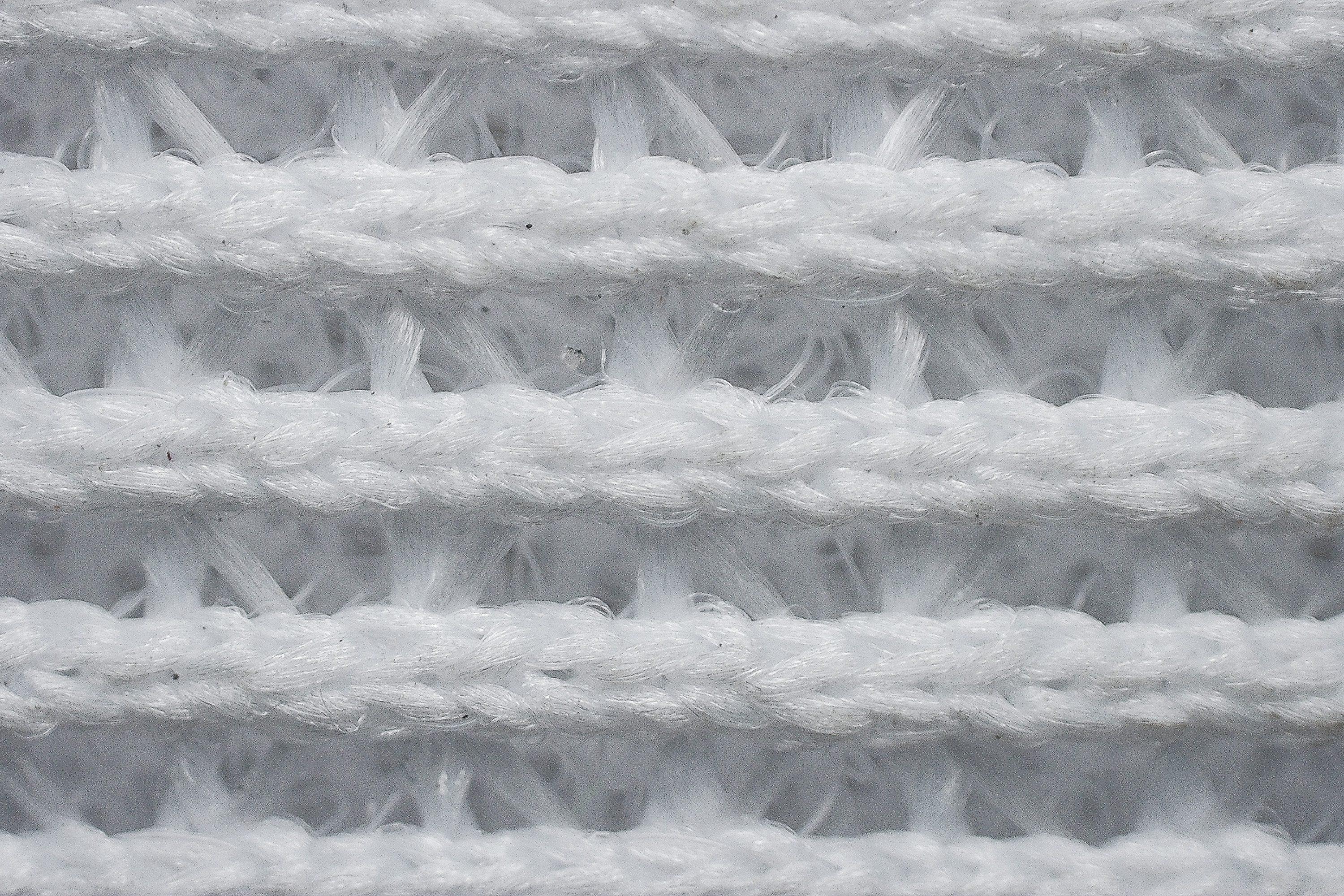
All things considered, the Nike GP Challenge Pro earns a lower-than-average breathability score of 3.
| GP Challenge Pro | 3 |
| Average | 3.2 |
Stability
Lateral stability test
The Nike GP Challenge Pro ticks all the boxes of a stable tennis shoe. And the exaggerated blocky outriggers on its lateral side are only the most obvious ones.
Torsional rigidity
Do you know that nasty feeling of rolling your feet over the edge of the shoe? Or the more unfortunate case of an ankle twist?
Well, both are very unlikely to happen in a shoe that has a ton of torsional rigidity. And when a shoe can't be twisted sideways that easily, it won't let your foot roll either.
Checking the Challenge Pro's torsional stiffness in our manual test, we can guarantee a stable footing in this shoe. On a 1-5 scale, where 5 is the stiffest, we rated it with a high score of 4.
This is largely provided by the stiff midfoot shank embedded into the shoe's midsole (the light green component beneath the Swoosh).
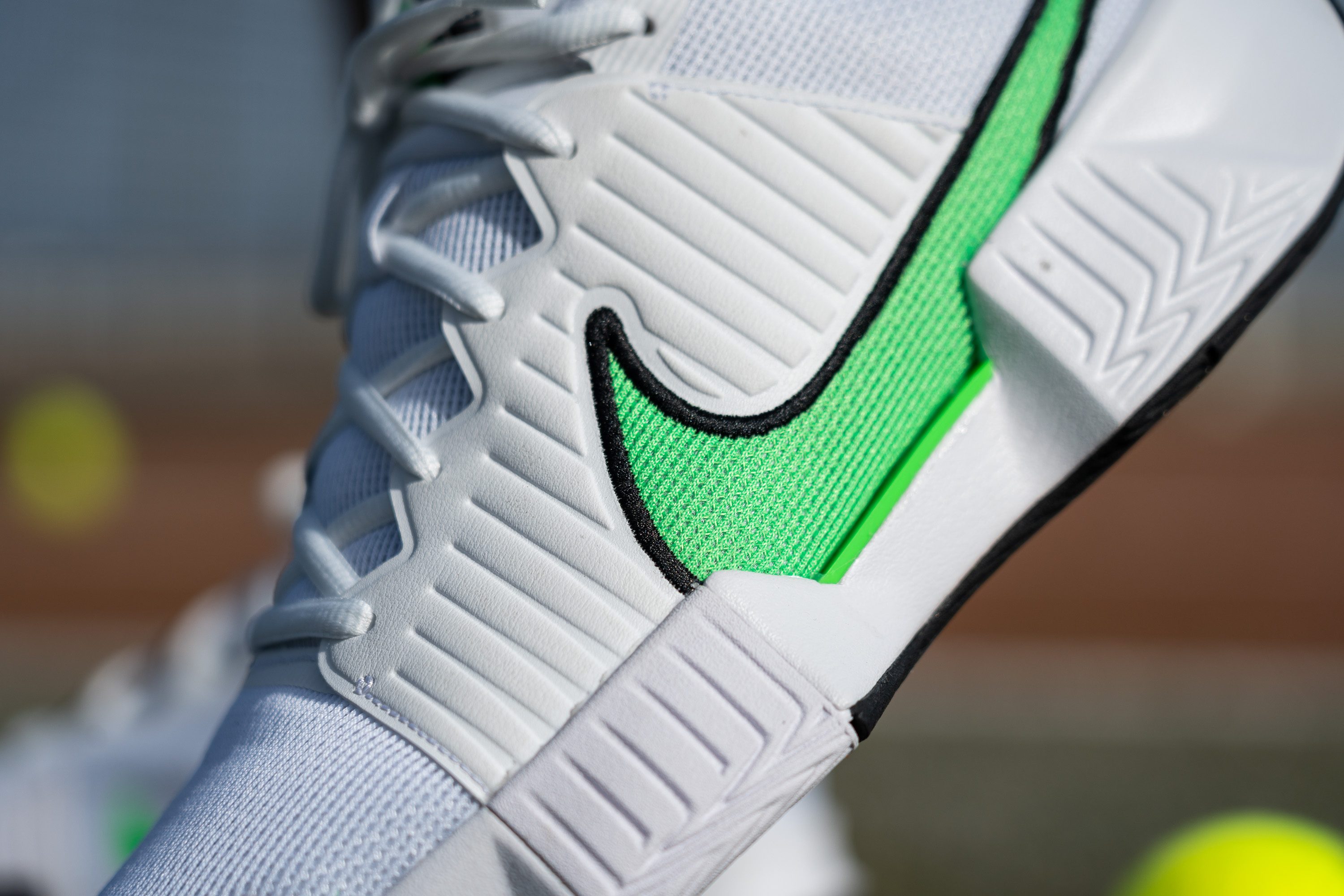
We must also add that the shoe felt incredibly supportive throughout our playtest. It kept our feet securely in place even on the most aggressive lateral moves.
| GP Challenge Pro | 4 |
| Average | 4.4 |
Heel counter stiffness
A game of tennis demands a lot from the shoe's heel hold. It's got to be ready for the most rapid changes or directions as well as abrupt stops both forward and side-to-side.
That's why we assess how stiff and structured the heel counter is on every tennis shoe.
Our manual squeeze-and-push test revealed that the Nike GP Challenge Pro has a fairly rigid heel counter. On a 1-5 stiffness scale, we gave it a solid score of 4.
We never had issues with in-shoe sliding or heel slippage throughout the playtest.
| GP Challenge Pro | 4 |
| Average | 4.1 |
Midsole width - forefoot
When we first saw the GP Challenge Pro, we were immediately struck by its large protruding outriggers on the lateral side. They look (and feel) exactly like brick walls that don't let the foot roll uncontrollably.
Of course, these blocks extend the width of the shoe's platform far above the average.
Measuring the widest part of the forefoot with a caliper, we got 115.8 mm which makes it one of the widest in our roster of tennis shoes.
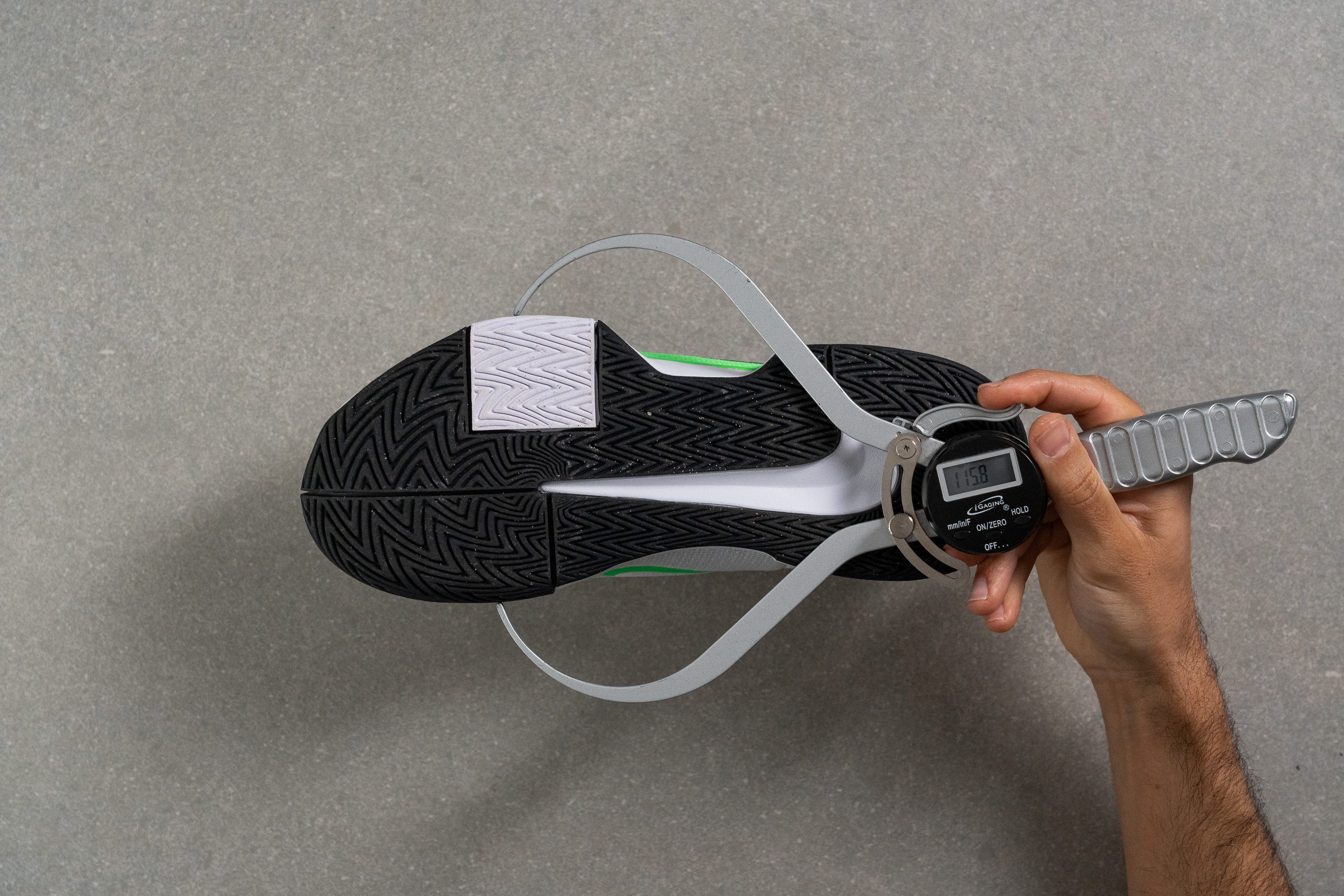
| GP Challenge Pro | 115.8 mm |
| Average | 111.9 mm |
Midsole width - heel
The outrigger in the shoe's heel also protrudes further than the average. With a caliper reading of 93.9 mm in the widest part, it is about 4 mm wider than most tennis shoes.
Having such a broad platform made us feel wonderfully planted whether it was at the baseline or when moving around the court.
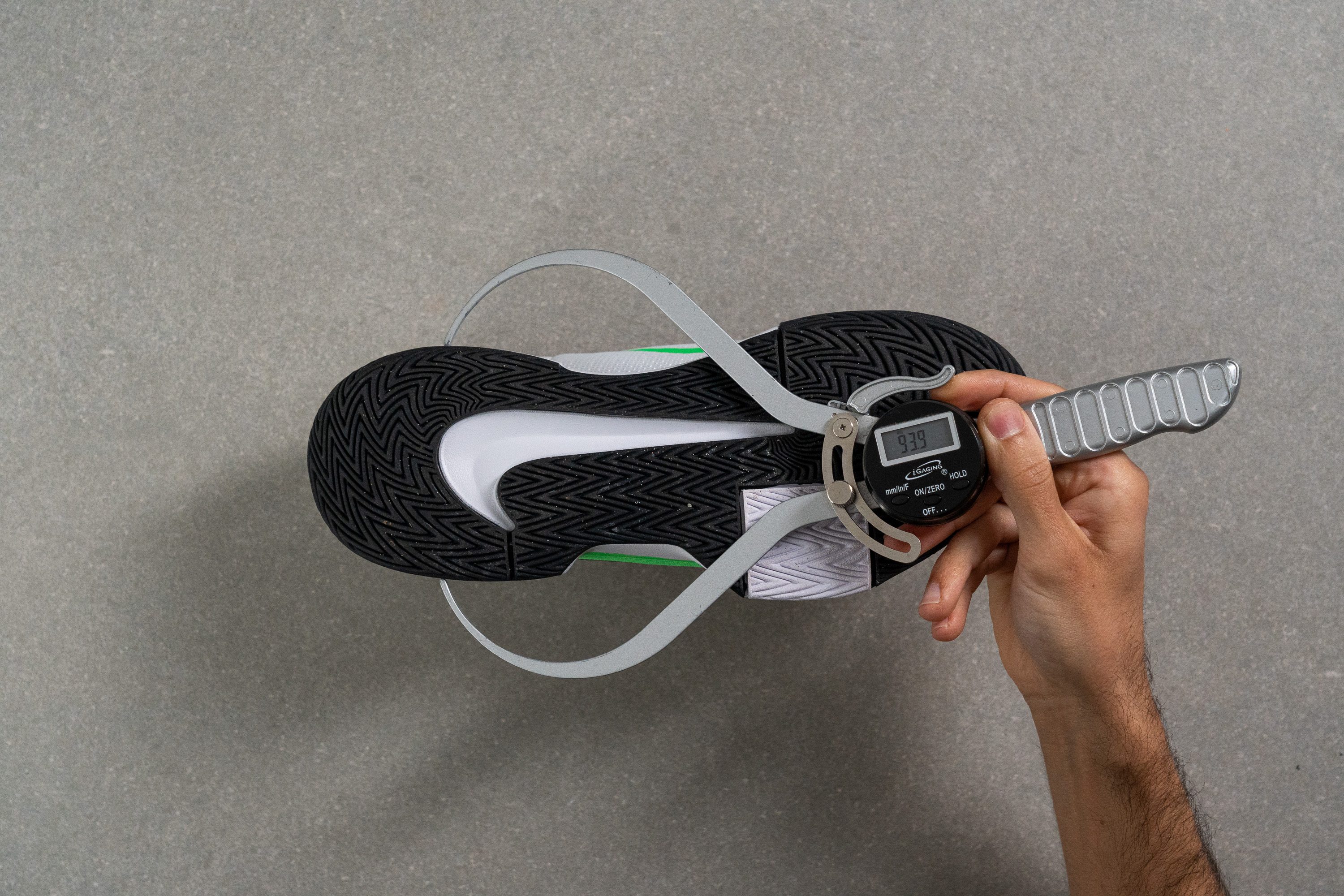
| GP Challenge Pro | 93.9 mm |
| Average | 89.6 mm |
Midfoot cage
Last but not least, the Nike GP Challenge Pro features a synthetic midfoot cage to enhance the foothold.
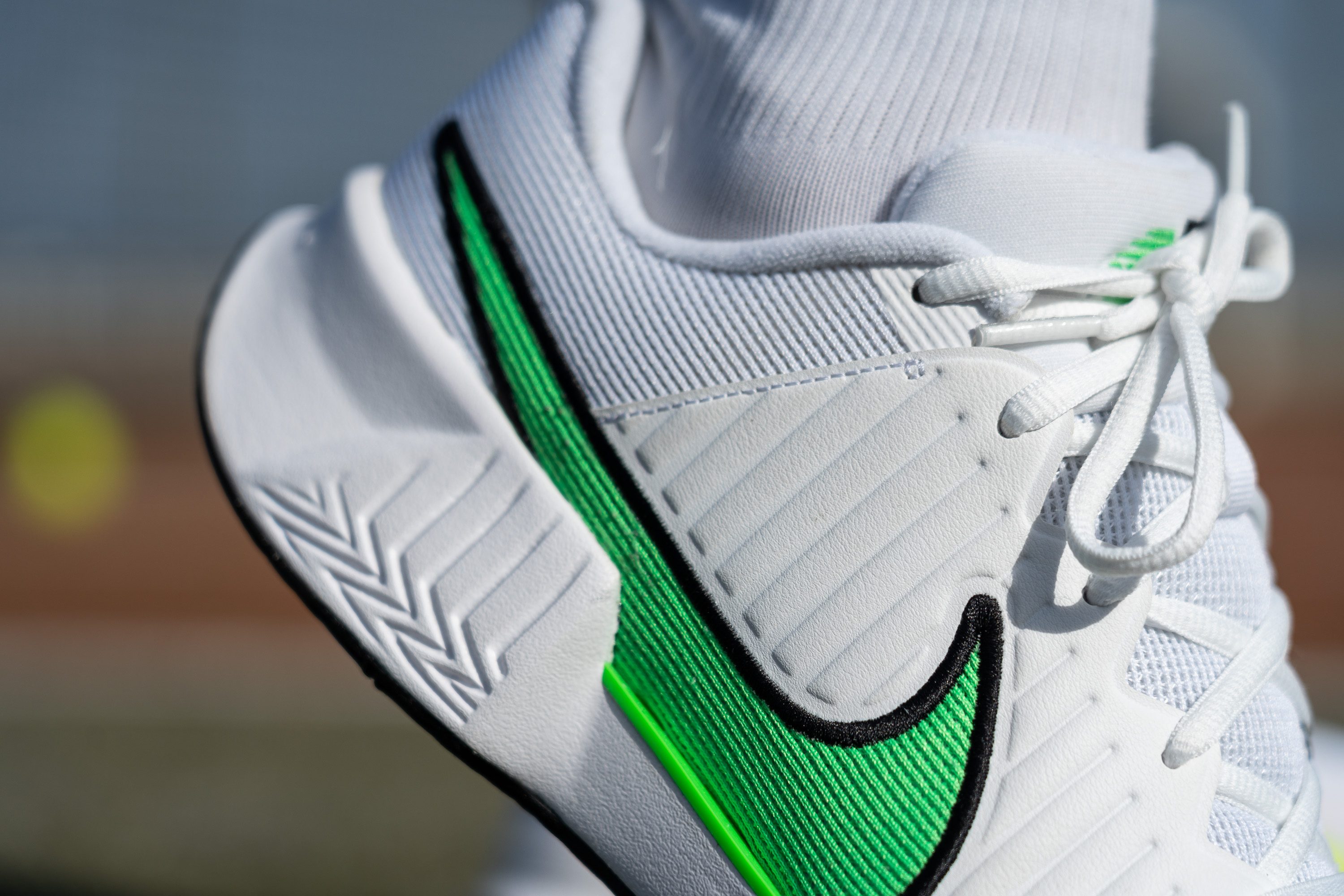
Placed on both sides of the shoe, these thick and wide overlays are also integrated with the lacing system. Once the shoe is fully cinched up, the side support comes into play as well.
And if you want next-level side support, check out Nike's GP Challenge 1. It features even sturdier TPU overlays to hold the midfoot in place.
Durability
Toebox durability
In tennis shoes, the medial side of the toebox is most prone to abrasion due to toe drags. Nike made sure that the Challenge Pro has enough protection here by covering it with a sturdy rubber guard.
It even raised the edges of the outsole to protect this highly sensitive area.
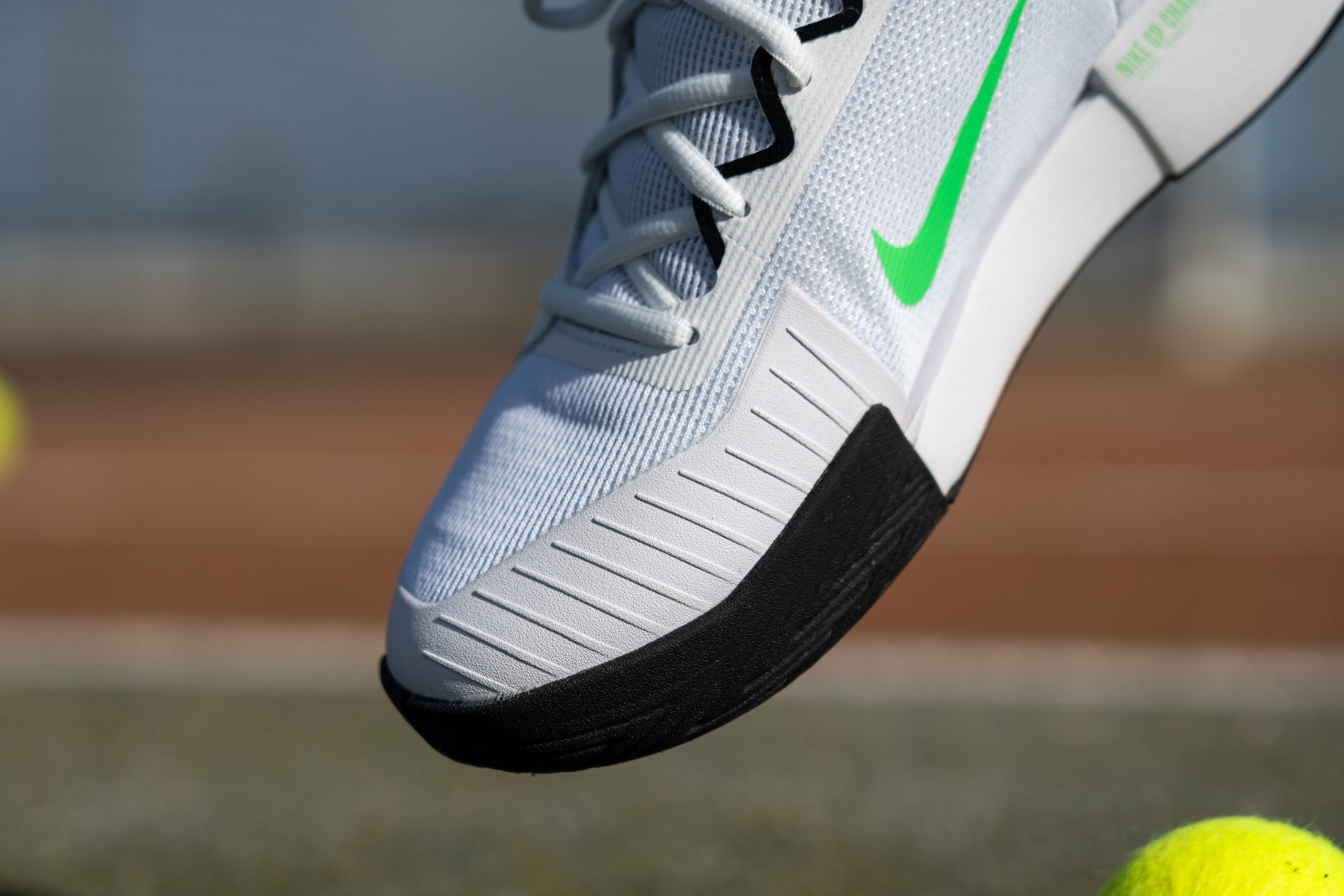
However, the shoe's exposed parts turn out to be less wear-resistant. Accidentally slashing them against the court is likely to result in a serious tear.
A quick durability test with a Dremel proved our concerns. Having applied the tool's sandpaper tip to the unprotected part of the shoe's toebox for 12 seconds, we saw significant damage to the fabric.
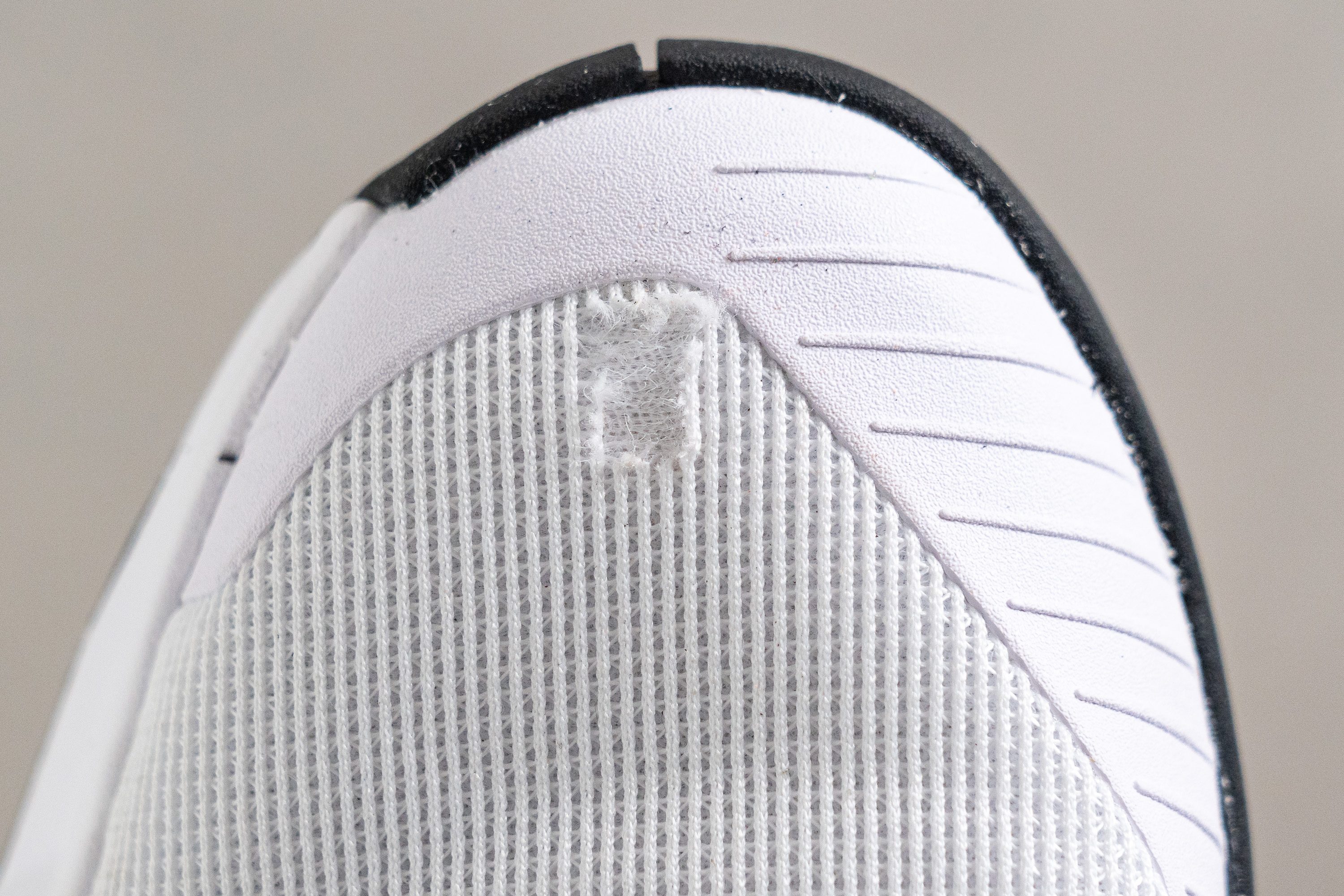
Luckily, it was not a see-through hole so this Nike shoe earned a point.
All in all, we rated the Challenge Pro's toebox durability with 3 out of 5. This is lower than average but is fair enough for a more affordable tennis shoe.
| GP Challenge Pro | 3 |
| Average | 3.7 |
Heel padding durability
On the other hand, the shoe's seemingly delicate inner lining showed a higher score in our Dremel tests.
Keeping the speed at 5K RPM, we applied the tool to the back of the collar for 4 seconds. It left a barely noticeable scuffing which convinced us to rate the shoe's heel padding durability with a high score of 4 out of 5.
Looks like the shoe's inner lining is ready for lots of friction!
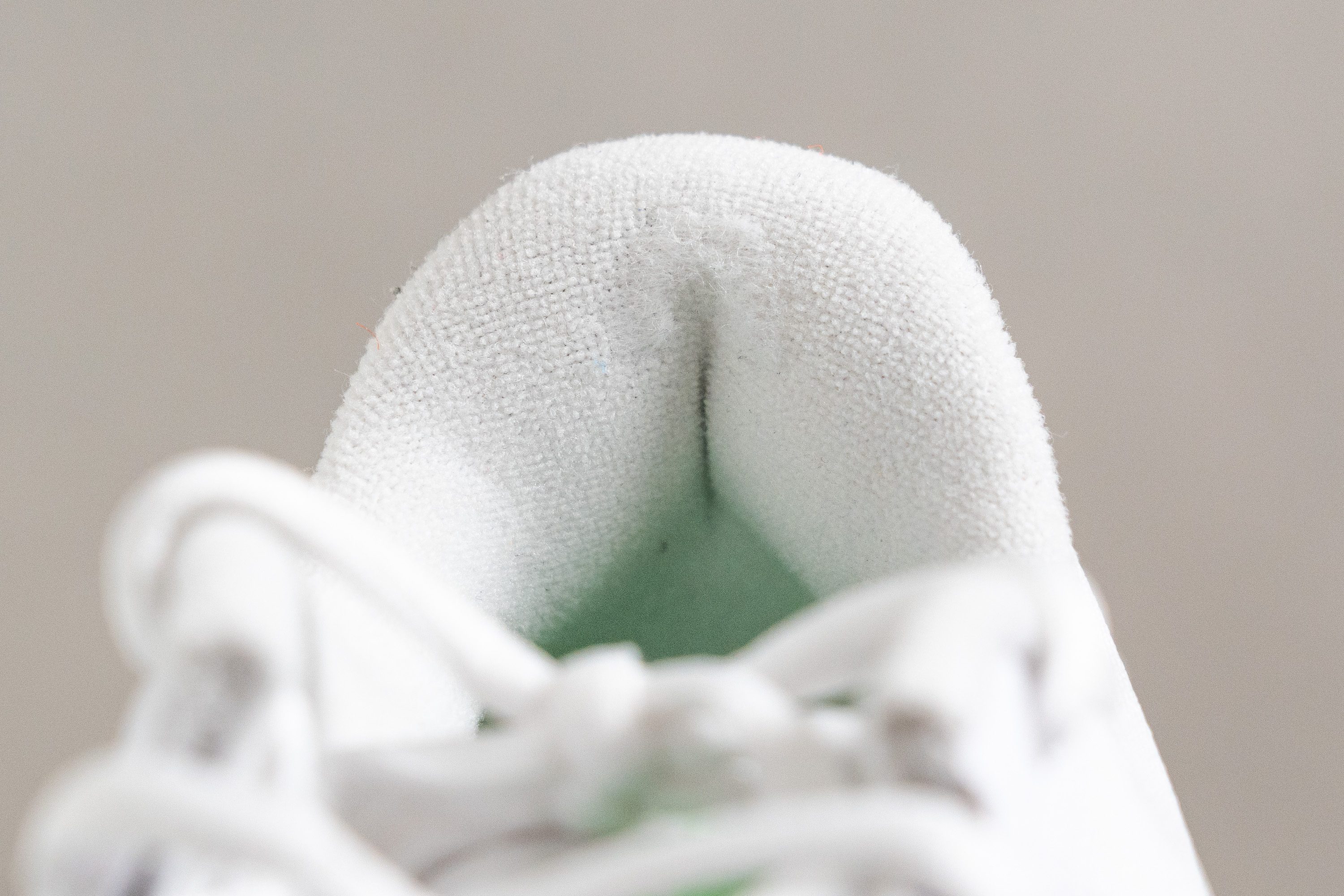
| GP Challenge Pro | 4 |
| Average | 3.3 |
Outsole hardness
The shoe's outsole surprised us with a very hard rubber compound. Pressing our durometer against it returned a reading of 87.5 HC. That's harder than average!
And from our experience, harder rubbers tend to be more abrasion-resistant too.
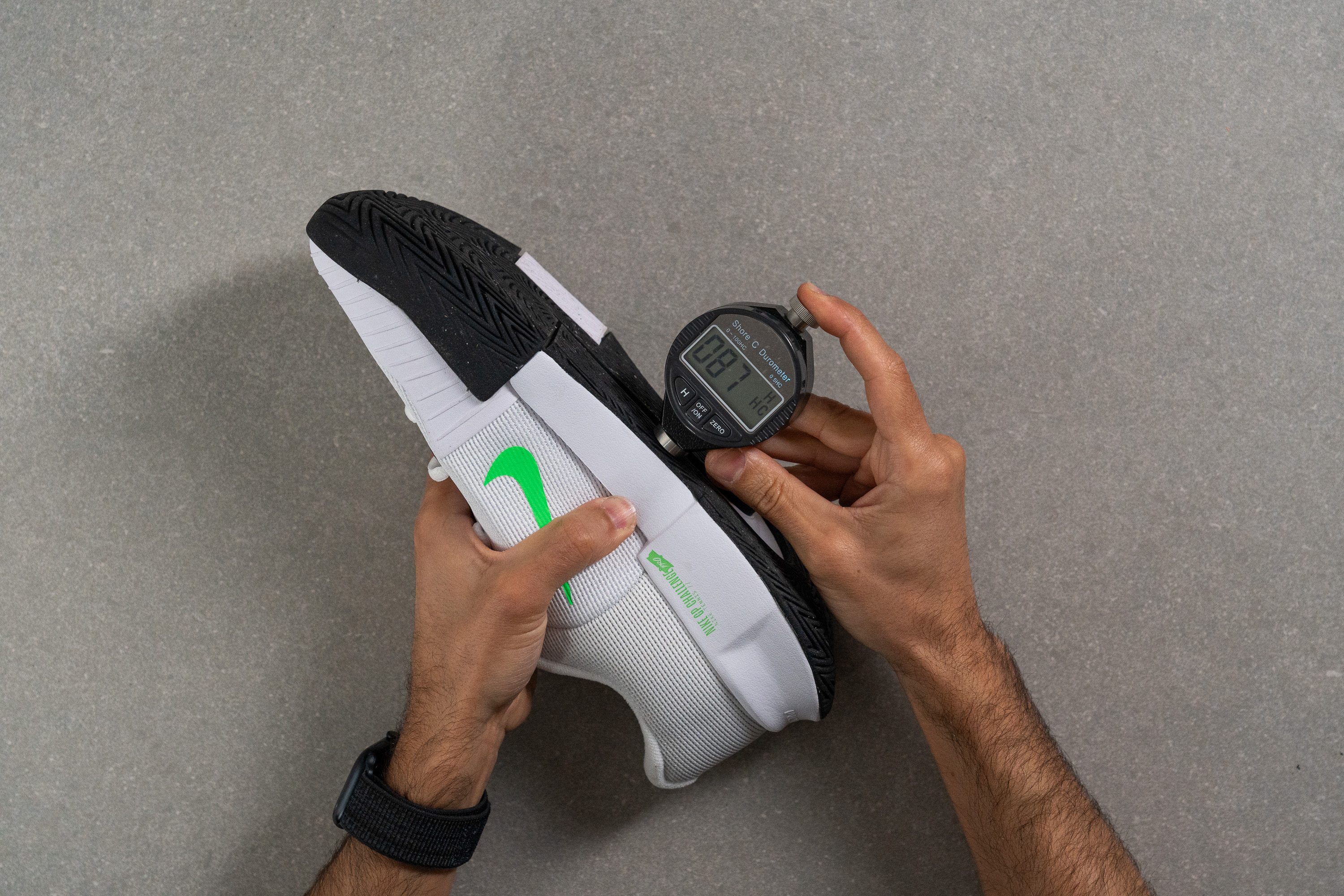
| GP Challenge Pro | 87.5 HC |
| Average | 86.0 HC |
Outsole durability
But let's test our assumptions with a Dremel.
First, we set the Dremel speed to the demanding 10K RPM and held its sandpaper tip against the shoe's outsole for 22 seconds. For the record, the pressure of the tip remained consistent (3.2N) for the entire test.
After that, we measured the dent which appeared on the outsole with a tread gauge. And this is where we must say "Wow!" It was only 0.6 mm deep, just the same as the average.
Even though this Nike tennis shoe is cheaper than average, its outsole durability is comparable to some of the pricier shoes.

| GP Challenge Pro | 0.6 mm |
| Average | 0.8 mm |
Outsole thickness
The GP Challenge Pro also has a decent amount of rubber in the outsole. With a caliper measurement of 3.5 mm, it is slightly (but not critically) thinner than average.
But given its impressive abrasion resistance, we expect average longevity from this Nike shoe's outsole.
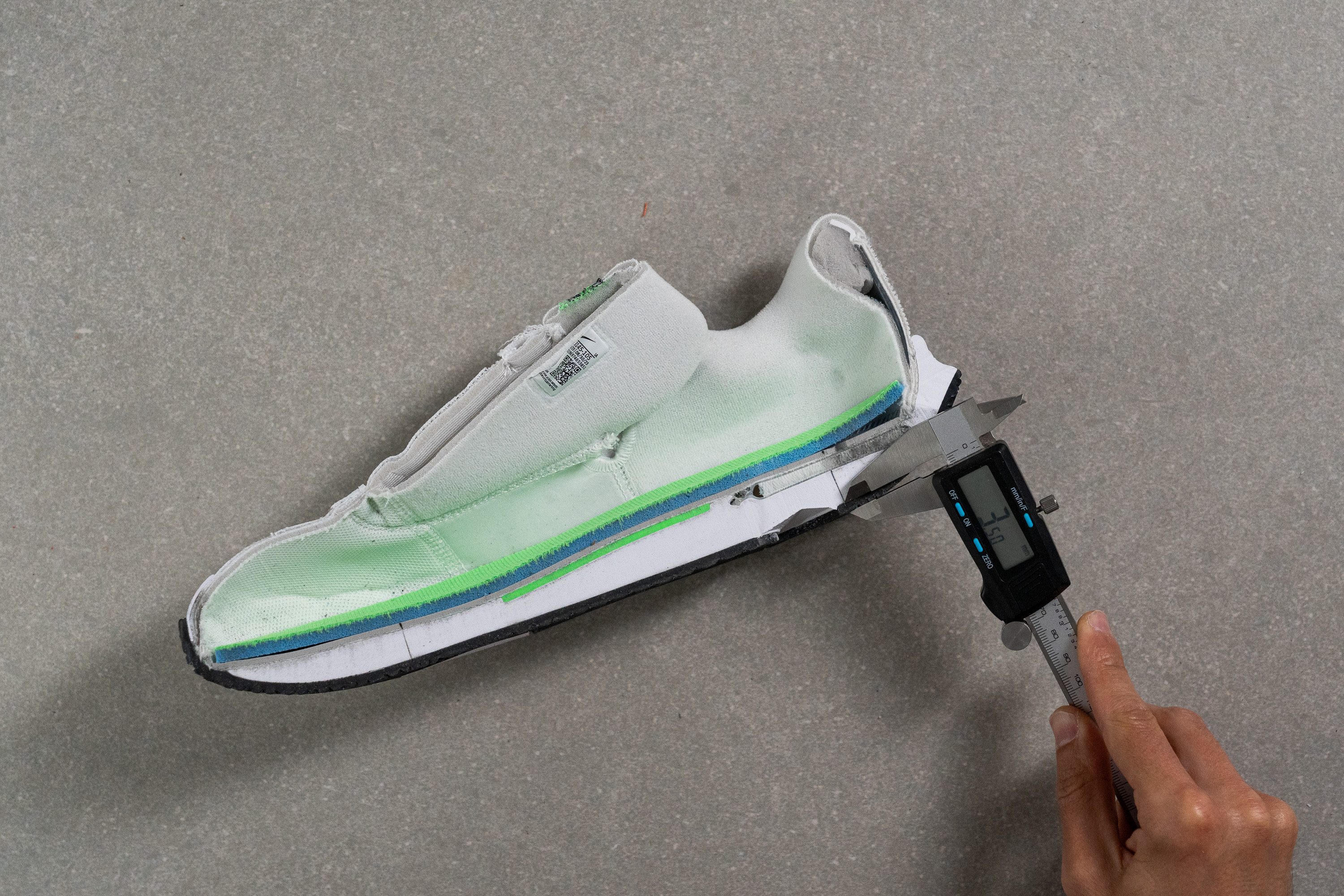
| GP Challenge Pro | 3.5 mm |
| Average | 4.2 mm |
Misc
Insole thickness
The shoe comes with a padded insole to buffer the foot from the firm midsole and the stiff shank. We measured its thickness at 4.7 mm which is slightly thinner than average but just right to feel comfortable in this Nike shoe.
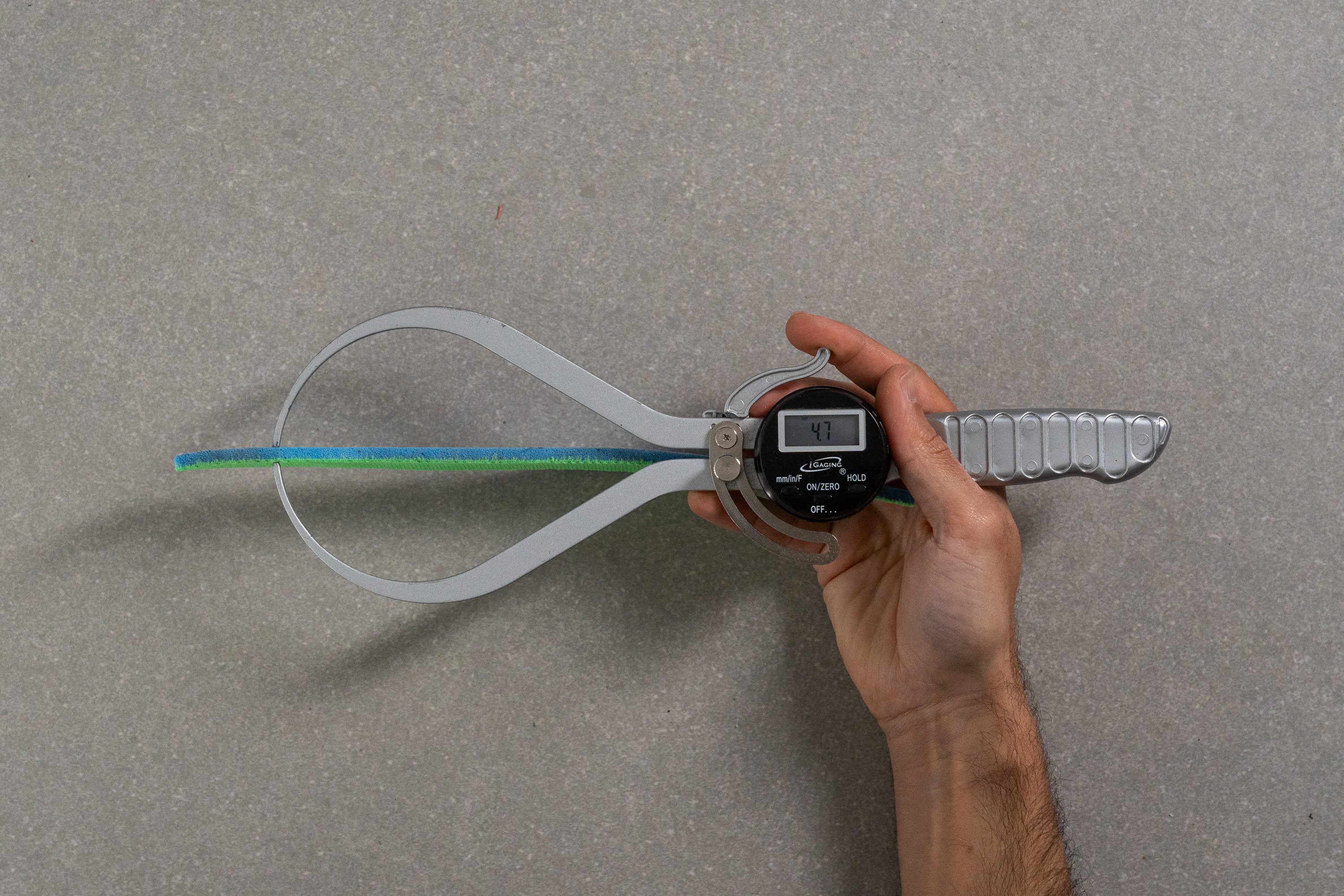
| GP Challenge Pro | 4.7 mm |
| Average | 5.1 mm |
Removable insole
This Nike shoe comes with a rather basic insole with no extra features. It is neither contoured nor moisture-wicking. But the good news is that you can easily remove and swap it for an orthotic of your choice.
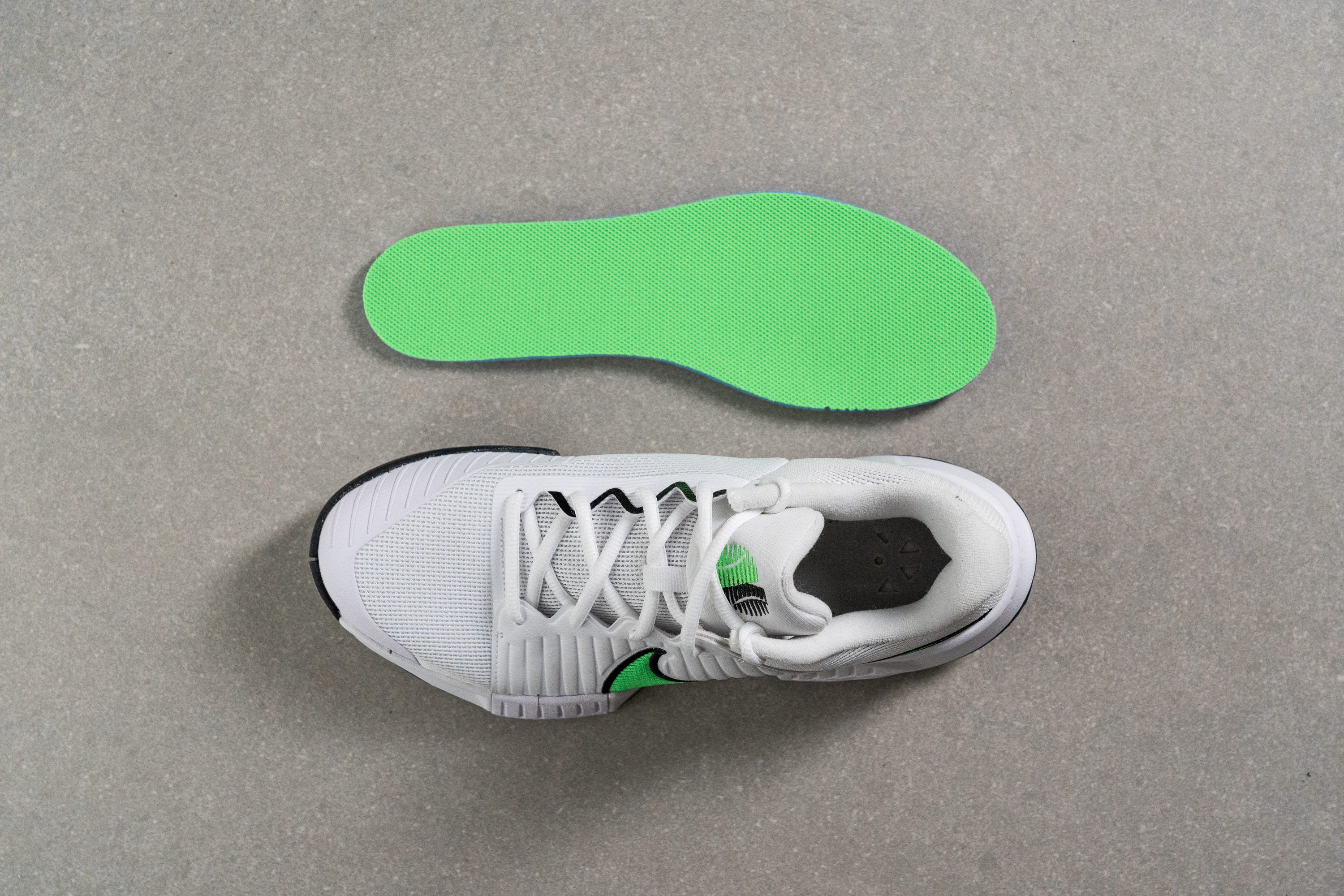
| GP Challenge Pro | Yes |
Tongue padding
The Nike GP Challenge Pro has an amazingly comfortable step-in feel thanks to its well-padded interiors. Its tongue is on the thicker side of the spectrum with a caliper measurement of 11.3 mm.
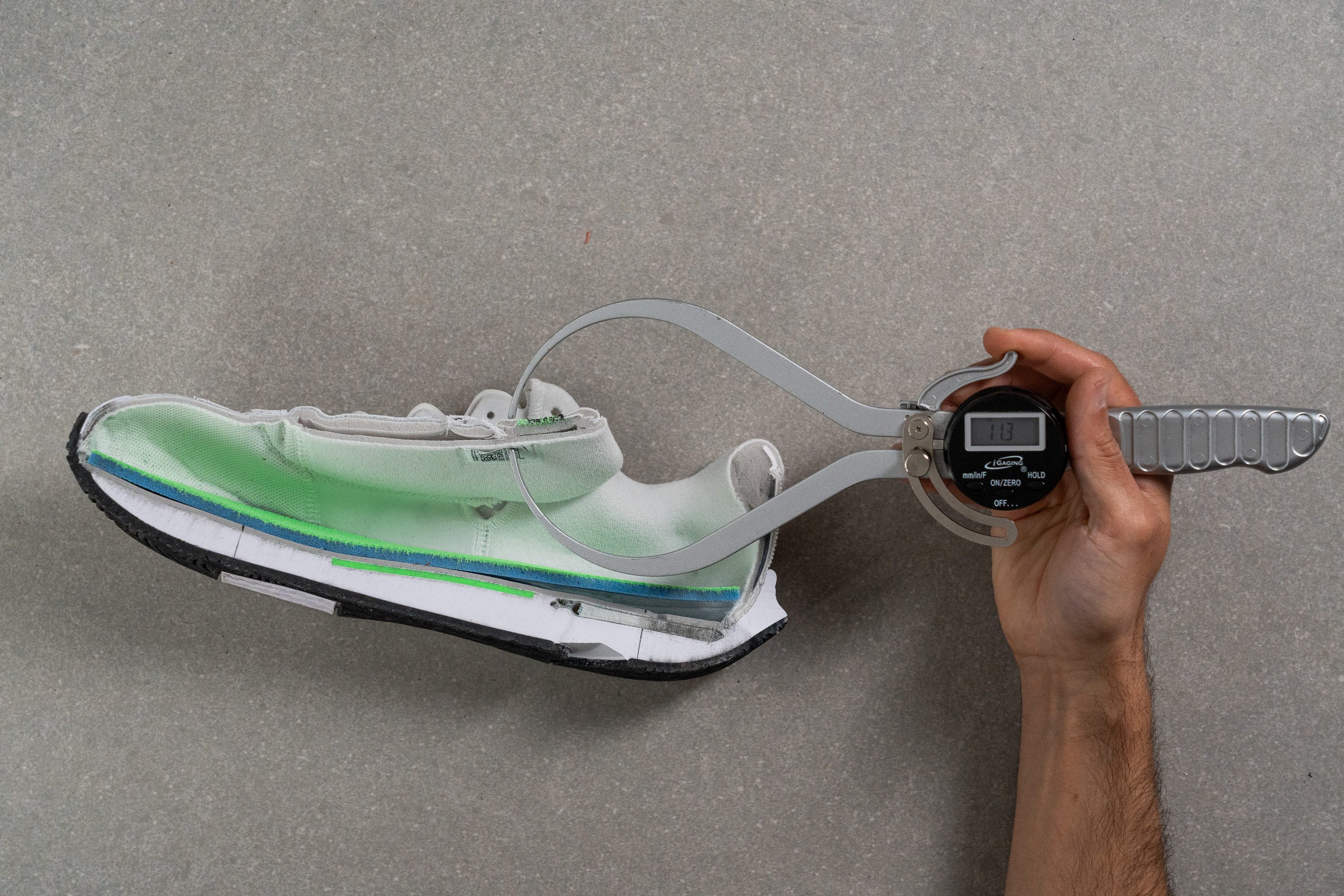
| GP Challenge Pro | 11.3 mm |
| Average | 8.1 mm |
Tongue: gusset type
One big advantage of the GP Challenge Pro is its gusseted tongue. We love how this seemingly minor feature makes a big difference in the shoe's foothold.
We felt securely locked on at all times during the playtest and there was no tongue sliding or bunching whatsoever.

| GP Challenge Pro | Both sides (full) |
Heel tab
There are no finger loops or heel tabs at the back of the Challenge Pro. However, its collar has a so-called U shape which is specifically designed for easier on-and-off action.
Having worn this Nike shoe more than a few times, we can subscribe to that statement.
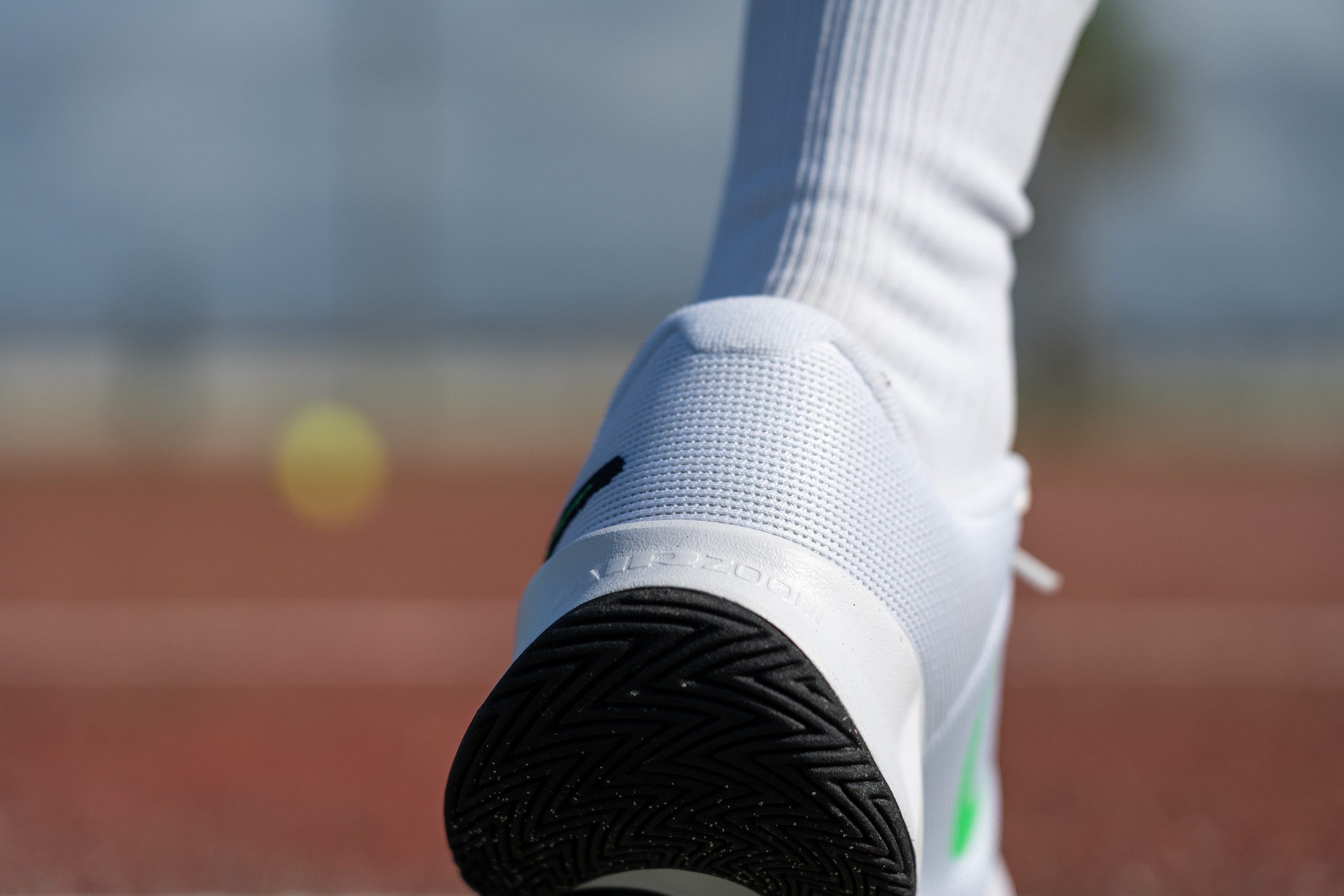
| GP Challenge Pro | None |

